
Is There a Maximum RV Tire Temperature?
- Description
- Discussions
We recently received a question from a member in regard to their RV’s tires. They asked whether there was a maximum RV tire temperature that their tires should not exceed when in operation on the road. In this free lesson, RV expert Dave Solberg answers the member’s question, and gives a few helpful tips on maintaining RV tires so that they remain in proper working order and achieve their maximal lifespan.
Although there is no maximum RV tire temperature as provided by most tire manufacturers, Dave does advise that you be wary of any drastic fluctuations in tire temperature as you’re heading down the road. The majority of modern motorhomes, fifth wheels and tow trailers have monitors that warn the driver when temperature is approaching or at 156 degrees. If you notice that the temperature of one or multiple or your tires has steeply risen, this is a clear sign that something has gone wrong and your cue that you should address the issue before a more serious issue arises. Possible malfunctions include dropping pressure and locking brakes.
Keeping an Eye on Your RV Tires
To ensure you get the most out of your RV tires, which should last no less than 10 years, Dave recommends paying close attention to the statistics you can find on the sidewall of every tire, be it single or dual. All info, including maximum weight capacity and the standard PSI of 80, is listed here.
If you keep an eye on your RV tire temperature and be sure to occasionally inspect the wear pattern and condition of your tires, you should remain in the clear. Remember, as Dave says it’s far more important that you’re aware of any dramatic fluctuations in temperature than worrying about peak temperature itself. For more helpful insight on RV tires , check out some of our other handy, expert-taught tire maintenance videos!
Share tips, start a discussion or ask one of our experts or other students a question.
Already a member? Sign in
2 Responses to “Is There a Maximum RV Tire Temperature?”
For the last 5 years I have carried a laser thermometer in my console …Every time I stop I grab it and hit each tire and hub. Looking for heat.. With time and use I trust it more than a tire gauge. It will tell you when a bearing is getting hot before any smoke. It only takes a minute to walk around the whole rig to include the truck. Get in the habit and you will learn much more about your rig and potential problems before they get really expensive. All the big box stores have them for about $20. Don't leave home without it.
10 year is an interesting comment when everything I have read says to replace tires (regardless of miles) after 7 years for heavy duty and 5 years for auto or light vehicles!
Explore videos by Dave Solberg

You may be interested in
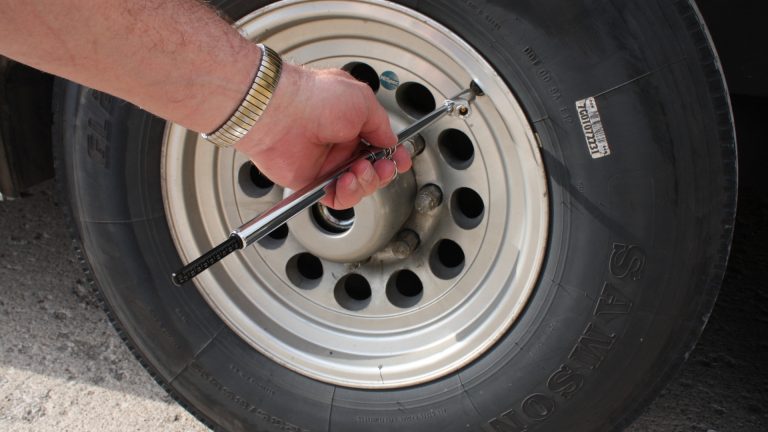
Premium Membership
Unlock exclusive member content from our industry experts.
- 24/7 Access to Premium RV Maintenance Videos, Travel Inspiration, and Lifestyle Tips
- Step-by-Step Instructional Demos, Projects, and Guides
- 50% Off Video Downloads Purchased in the RV Lifestyle & Repair Shop
- Access to Ask the Expert Program
- 2 Full-Length Video Downloads to Watch Offline
Gold Membership
Get everything included in Premium plus exclusive Gold Membership benefits.
- 9 Full-Length Video Downloads to Watch Offline
- 2 Full-Length RV Repair Classes to Keep for Life
- Discounts on Purchase-to-Own Content in the RV Lifestyle & Repair Shop
- Exclusive GOLD LIVE Streaming Events
Username or email *
Remember me
Lost your password?
Privacy Policy

This post may contain affiliate links or mention our own products, please check out our disclosure policy .
How Hot is Too Hot for RV tires?
Published on August 23rd, 2023 by Emily Lawrence This post was updated on March 19th, 2024
Summer temperatures seem to be climbing higher every year. This is great for seasonal RVers who want to take advantage of the warm weather and explore the country. However, heat can also cause a variety of problems for your vehicle. This begs the question: How hot is too hot for RV tires?
Tires are designed to be extremely durable and heat-resistant. After all, they have to withstand a tremendous amount of weight and friction. But even the best RV tires have their limits. Extremely hot temperatures can damage or even destroy your RV tires.
Learn how to prevent heat damage and keep tires longer.
If your tires are a bit old and worn down, they’re more likely to succumb to heat damage. But it can happen to anyone at any time, so it’s important to be vigilant and proactive in your approach. Read on to learn more about how heat can damage RV tires, and what you can do to prevent these problems.
DON’T MISS OUT ON RV LIVING UPDATES
Sign up for the newsletter today.
Please enter a valid email address.
An error occurred. Please try again later.

Thank you for subscribing to the RV Living newsletter, keep your eye on your inbox for updates.
All About RV Tires and Heat
When you think about RV tires overheating, you probably imagine it’s because they spin too fast or are exposed to high outdoor temperatures. Although these factors can certainly play a role, heat damage usually takes place over a long period of time instead of a single hot day.
Prolonged exposure to hot, dry conditions can wreak havoc on your tires.
In this situation, tires can hold up just fine for a while, but eventually it takes a toll. And once the damage begins, it’s nearly impossible to fix. You can apply short-term solutions, but in the end, you’ll always need to replace the tire.
This is why it’s important to discuss the relationship between tires and heat. Tires are designed to survive immense friction (and, therefore, high temperatures).
But if there’s a flaw in the design, or the rubber begins to break down, the heat builds up more and more. The rubber will soften and stretch as it heats up. This exacerbates the problem even further! Eventually, you could reach a state where the tire bursts or melts.
Over time, tires naturally age and break down.
However, you need to keep an eye out for dry rot. This occurs when a tire’s protective oils and coatings begin to dry out. Once the protection is stripped away, the rubber may begin to crack and crumble.
Frequent changes in temperature, humidity, and elevation can also cause the rubber to shrink and stretch. Carefully monitor your tires and do everything you can to keep them in prime condition.
How Hot is Too Hot for RV Tires?
Answering the question “How hot is too hot for RV tires?” is tricky, but you can start by looking at some rule-of-thumb measurements.
In general, your tires should never exceed 200 degrees Fahrenheit.
Some tire models break down at around 220 degrees, but you don’t want to push too close to the upper limit.
However, it’s also worth mentioning that it’s difficult to accurately measure your tire temperature. The hottest part of a tire is usually around the radial belt, and this can be hard to reach without a needle probe. The outside of a tire will usually be cooler than the inside because of airflow.
Tire pressure monitoring systems are helpful (even if they only measure the temperature inside the tire rim).
TPMS systems don’t tell the whole story about tire temperature. That’s because tire rims are often significantly cooler than the tire interior. But if your TPMS is alerting you to high temperatures, you can assume that you’re approaching a dangerous level. Most TPMS systems will flag any tire temperature of 158 degrees or more.
As you can see, it can be difficult to concretely determine the hottest temperature RV tires can tolerate. But if you listen to your TPMS or register a temperature of 200+ degrees some other way, you need to stop driving for the day to let your tires cool off.
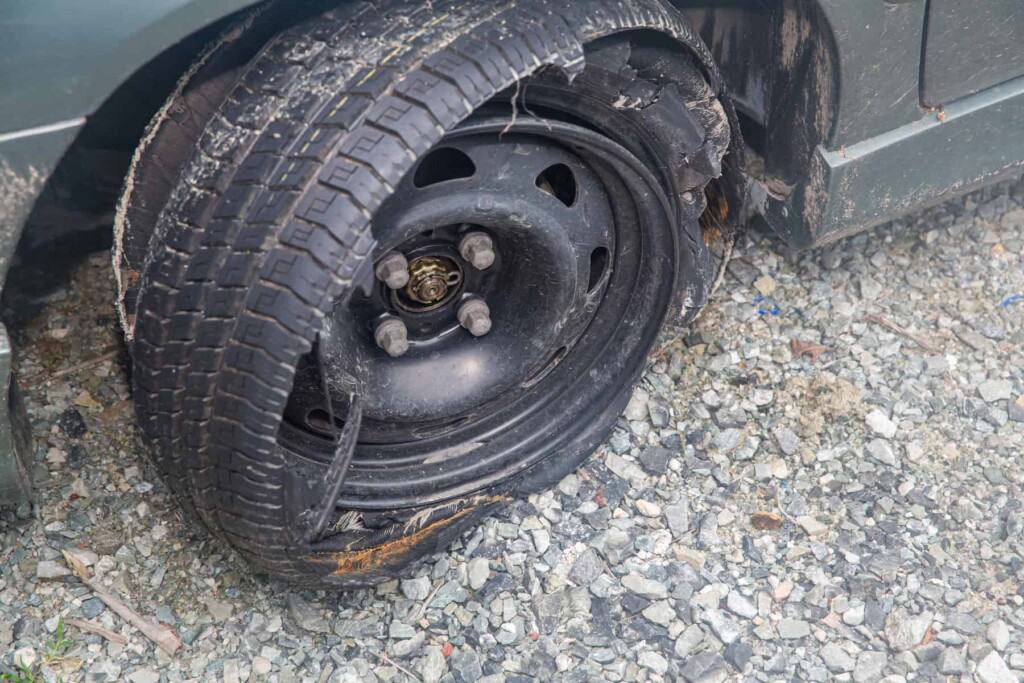
8 Warning Signs Your RV Tires Are Unsafe
Although tires can always develop unexpected leaks, it’s rare for a tire to blow without warning. If you regularly inspect your tires, you’ll be able to spot early warning signs. The problems are particularly visible during seasons with extreme temperatures (typically summer and winter).
If you suspect that the weather is becoming too hot for RV tires, look out for the following issues:
Excessive tread wear
Tread/rim separation, cracks in the sidewall, cuts, nicks, and scratches, air pockets (bulges, blisters, lumps), faded tire color, bluish tint on tire surface, vibration/difficult handling.
If you spot any of these issues in your RV tires, it’s time to look for a new set. As we mentioned earlier, heat damage is impossible to fix once it takes over. But you can protect your next set of tires by following the tips below.
You also need to keep a close eye on your tire pressure.
Temperature changes can cause your tires to swell or shrink. If the tires are overinflated, the center of the tread will wear down faster than the sides. On the other hand, when tires are underinflated, the sides bear the brunt of the force.
Use your tire pressure monitoring system to ensure that all your tires are set to the correct pressure every day.
5 Ways to Protect Your RV Tires from Heat Damage
RV tires can be pretty expensive, and the money adds up if you frequently have to buy new sets. If you take the right preventative measures, you’ll be able to preserve your tires for a nice long time. Here are five ways to protect your RV tires from heat damage.
1. Be aware of the tire temperature
First of all, you need to know when it’s too hot for RV tires. Of course, you won’t be driving anywhere where the daily temperature is over 200 degrees! But you need to remember that tires can get hotter than the surrounding air.
If you’re traveling through a particularly hot area, be sure to check on your tires as you go. Give them time to cool down if the TPMS alerts you. Pay attention to any handling issues or smells of burning rubber too!
2. Refresh tire coatings during cleaning
Heat can cause a lot of problems for your wheels. But dry conditions can make things much worse! If you’re in a hot, dry climate, your tires are at risk for dry rot. In order to prevent tires from crumbling and cracking, you need to reapply protective coatings. Wax-based cleaning products are safe enough to keep your tires clean and flexible.
If you are planning to use other tire protectants or cleaning products, read the product labels and be aware of what other chemicals are going on your tire. Stay away from using any cleaning products that are petroleum-based , as the products may degrade the rubber’s weathering agents that may lead to premature cracking. Goodyear.com
3. Use tire covers
UV rays can also speed up the process of dry rot. Any tire that’s under the direct sun is in danger. Therefore, you should use tire covers as often as you can. If you park your RV for extended periods, attach the tire covers. Don’t forget about your spare tires. If they are mounted on the back of your RV, be sure to cover them up. Any level of protection can help.
4. Limit the strain on the tires
Tires are more likely to explode if they’re under excessive pressure. Understand how GVWR impacts tire safety , and make sure your RV is at the appropriate weight. The less strain you put on the tires, the longer they’ll last.
5. Stick to regular tire maintenance
Keeping RV tires safe starts with RV maintenance . Stick to a schedule of general tire care practices. This includes things like switching between seasonal tires, rotating to ensure even tread wear, and washing your wheels along with the rest of the vehicle. If you prioritize your tires throughout the year, you’re less likely to encounter major problems down the road.
Related Articles :
- RV Tire Tips: Ensuring Safety and Efficiency All Year Round
- How To Prevent RV Tire Blowout [6 Great Tips To Keep You Safe]
- RV Spare Tire Covers and Why You Need Them
If you enjoyed this post Please Share:
Related posts:.
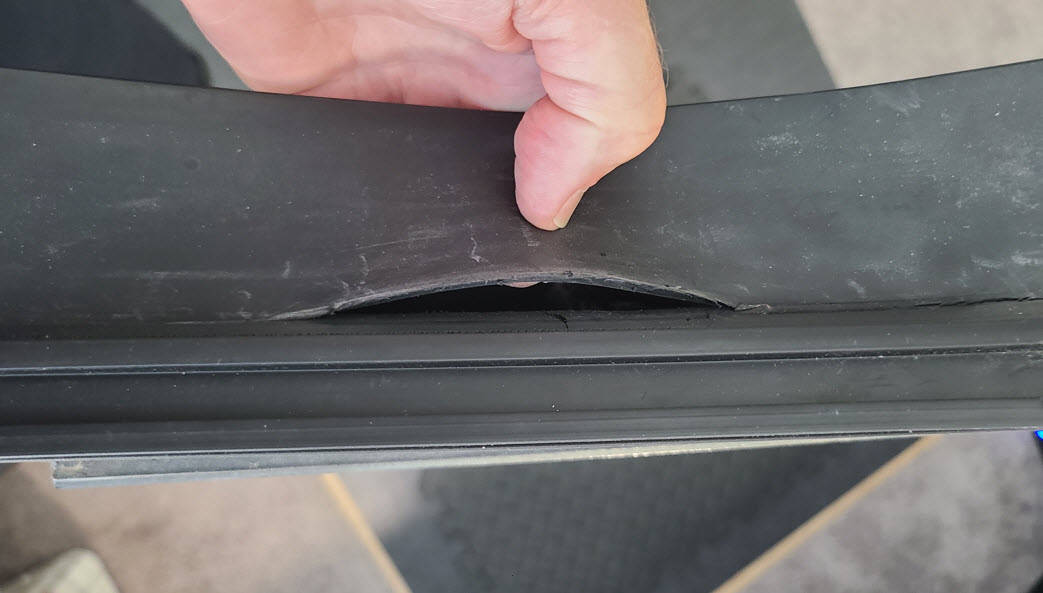
Tips for RV Seal and Seam Maintenance
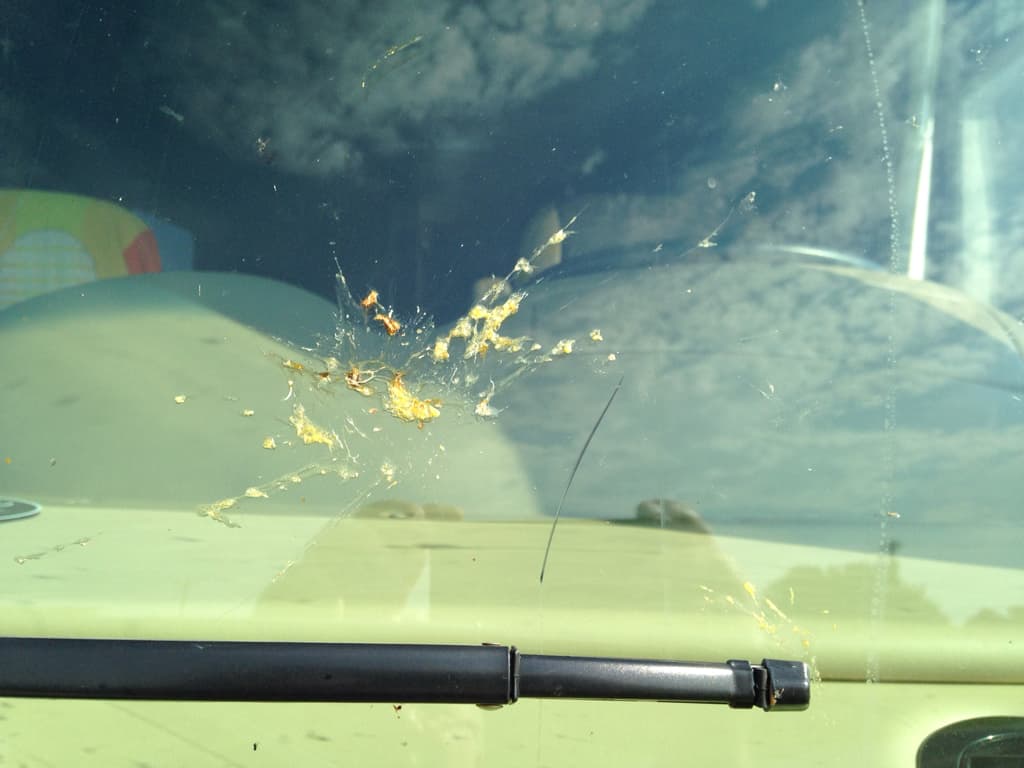
Four Ways to Clean Bugs Off Your RV During This Year’s Cicada Double Brood Boom
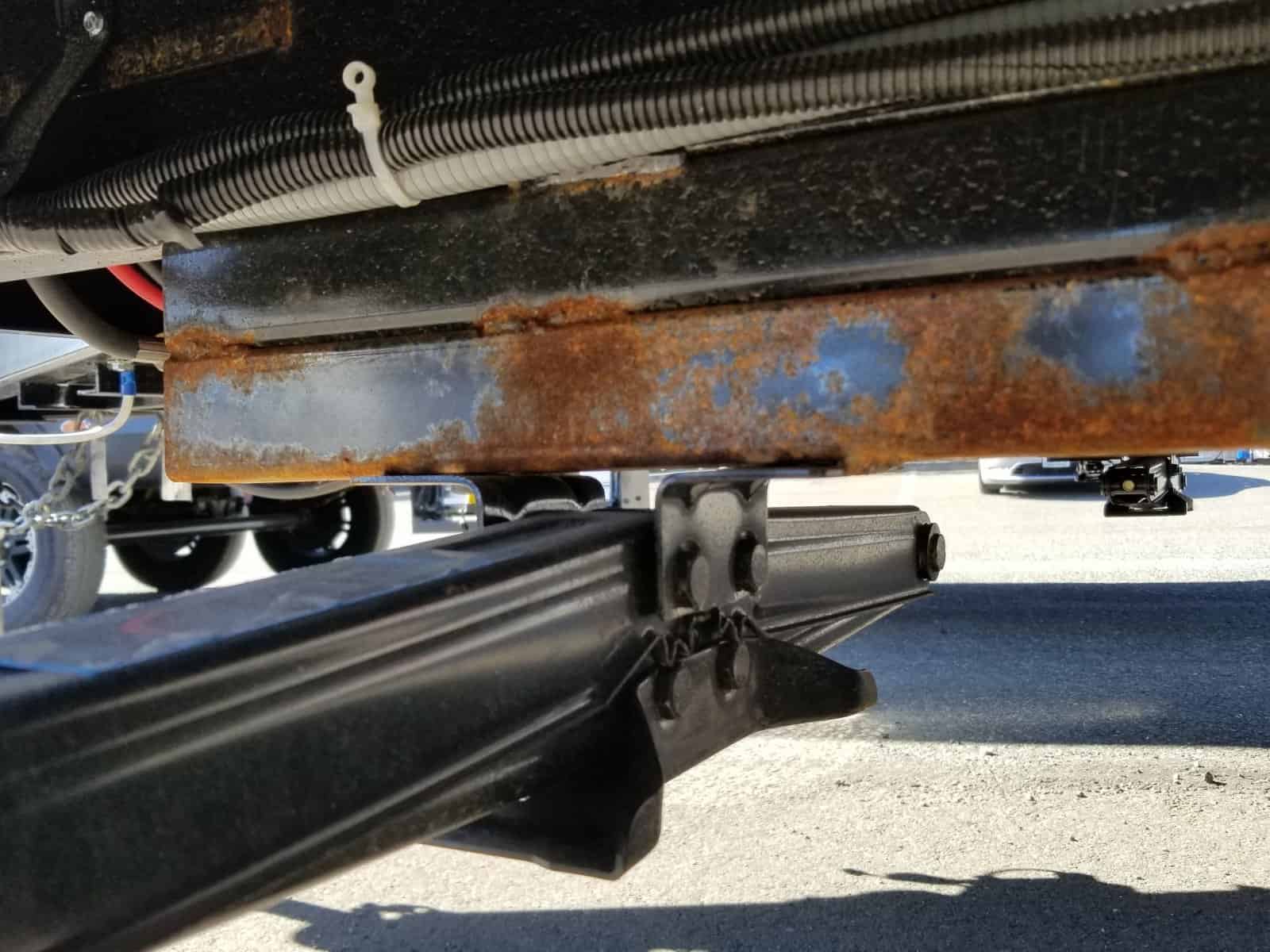
Remove RV Rust Before It Gets Out of Control
About the author:.

Emily Lawrence specializes in topics such as Campgrounds/RV parks, floor plans, and pest control. She loved camping growing up, and her family has a special campground they return to every year. “Road tripping is one of my favorite things, and I’m always looking for new RV models and campgrounds.”

- Find a Location
Everything You Need to Know About RV Tires and Trailer Tires

Because most motorized and towable RVs are driven less than passenger vehicles, their tires tend to last between three and six years on average. The more you drive, the more frequently you’ll need to replace your tires.
The tread wear is the metric to monitor over your tires’ lifespan. When that tread falls below a depth of 4/32”, it’s time to replace your RV tires. But even if your tires have plenty of tread left, keeping them for more than 8-10 years is not recommended.
Most RV and travel trailer tires should be replaced every 10,000 to 15,000 miles. But each manufacturer recommends a service life for their tires, so it’s best to seek their advice on tire replacement intervals.
RV tire covers can protect your tires from UV exposure, dry rot, and other wear and tear that can shorten your tire’s lifespan. Even if you aren’t driving your recreational vehicle a lot, leaving your tires exposed to the elements will decrease their serviceable life.
How to Change an RV Tire

Blowouts happen, so if you find yourself needing to swap a blown RV tire for a spare, you’ll need the following tools:
- Your RV may or may not have one. They are less common on Class A RVs due to the weight of the vehicle and the dangers of changing a tire on the side of the road.
- If you don’t, call Good Sam Roadside Assistance to get you back on the road.
- DO NOT USE your RV’s built-in hydraulic or stabilizing jacks to lift your RV.
- A lug wrench or torque wrench
- Impact driver with the correct size socket for wheel lugs
- Wheel chocks
- Tire inflator or air compressor with the appropriate fittings
With those tools in hand and your RV parked in a safe location, follow these steps:
- Retrieve your spare tire.
- Place wheel chocks in front and back of tires you aren’t changing to keep your RV from moving.
- Use your lug wrench to loosen all lug nuts holding the tire in place.
- Place the bottle jack under your RV’s frame.
- Extend the bottle jack until the tire is completely off the ground. I f the tire is blown, you need to extend it high enough for the inflated spare tire.
- Use your impact driver and socket to remove wheel lugs.
- Remove the blown tire and set it aside.
- Center the spare tire on the lug threads.
- Replace wheel lugs by hand (at least get them started by hand to avoid cross-threading).
- Initially tighten lug nuts with the impact driver.
- Retract the bottle jack to lower the tire onto the ground.
- Tighten lug nuts entirely with your torque wrench. All manufacturers recommend lug nuts be tightened to a specific torque setting.
- Use your tire gauge to check the pressure in your spare tire.
- If necessary, inflate your tire to the recommended PSI.
- Remove wheel chocks.
- Store the blown tire safely until you find a tire or service center to acquire a new spare.
- Store all your tire-changing tools.
Driving your RV without a spare in tow isn’t recommended. If you’ve had to install a spare, you should replace the original tire as soon as possible before continuing on your RV road trip.
How to Change a Trailer Tire

This process is largely the same for travel trailers . But there are a few additional pointers to remember. Follow the same steps as above, with these safety tips in mind:
- Ensure your trailer’s stability. Even if your trailer is hitched to your tow vehicle, you should place wheel chocks in front and back of the tire(s) you aren’t changing to prevent the trailer from shifting and potentially falling off your bottle jack. You may consider extending your trailer’s stabilizing jacks once your bottle jack is extended. This provides a backup to keep your trailer elevated if the bottle jack fails or slips out of place.
- Inspect the wheel hub after removing the old tire. This should be done for RV and trailer tires. Visually inspect the hub for cracking, buckling, or other signs of damage. If you notice any major signs of damage, contact roadside assistance before moving your RV.
- Find a replacement spare. Don’t travel far without a spare tire for your travel trailer or fifth wheel . Tires for smaller trailers can be harder to come by, but contacting your nearest Camping World Service Center is a good place to start when looking for the best trailer tire providers in your area.
How Much Are RV Tires?

Tire prices fluctuate depending on size, brand, weight capacity, and quality. But the average RV tire costs somewhere between $250 and $300.
Tires for Class A RVs tend to be more expensive than car tires or tires for Class C RVs because they are larger and heavier. Owners of Class B RVs will usually pay less per tire because they require smaller and lighter tires, but your cost may be higher if you decide to invest in higher-quality tires made for off-roading.
How Much Are Trailer Tires?
Most travel trailer tires are smaller than tires for motorized RVs. Their average cost is likely to fall between $100 and $200. But, of course, that cost can fluctuate depending on the exact brand, tire size, load range, tread pattern, and construction you’re looking for.
How to Identify RV and Trailer Tires

Trailer tires are usually identified by an ST or LT rating. ST stands for ‘special trailer tire,’ and LT stands for ‘light truck’ tires These ratings will be at the start of the tire’s label, such as ST 205/75 D14. Here’s a quick breakdown of the rest of that label:
- 205 denotes the tire width measured in millimeters.
- 75 states the tire’s height-to-width ratio (i.e. height = 75% of width in this case).
- D stands for ‘diagonal’ but also denotes a bias ply tire (R would denote a radial tire).
- 14 tells you the tire’s diameter in inches.
Radial or Bias Ply Tires?

Many RV owners don’t know they have options regarding the types of tires for their RV or travel trailer . Radial tires are more common, but bias ply tires are a reasonable alternative for certain uses. Here are some quick definitions:
- Radial tires are built with steel belts inside the tire running at a 90-degree angle to the tread center line.
- Bias ply tires are constructed with nylon belts running at a 30 to 45 degree angle to the tread center line.
The general consensus is that radial tires provide a smoother ride, less trailer bounce and sway, longer tread life, wider footprint, tougher overall construction, and the ability to run cooler.
Bias ply tires are generally less expensive and offer stronger sidewall construction. They also have the advantage when it comes to carrying heavy loads, as they offer a uniform number of plies to support weight in both the tire’s tread and sidewall.
The best tire type for your trailer is indicated on your trailer’s information label (D = bias ply, R = radial). Generally, radial tires are recommended for trailers used regularly for longer trips. Bias ply tires are recommended for tandem axle trailers used for shorter, less frequent trips.
What PSI Should My RV Tires Be?

RV tires have their maximum pressure stated on the tire’s sidewall. This maximum pressure should never be exceeded. That said, the RV manufacturer will usually state the recommended tire pressure for your RV, not necessarily the tire manufacturer.
The RV manufacturer’s recommended tire pressure rating can be found on your vehicle information label or in your owner’s manual. But it’s important to recognize that this pressure rating is for cold tires (i.e., when your RV or travel trailer has been parked for at least three hours).
Should Trailer Tires Be Inflated to Max PSI?

The dangers of over-inflating trailer tires include more difficulty braking and a higher likelihood of tire blowouts. Over-inflated tires also wear out quicker, don’t provide as much traction on wet roads, and can alter your fuel efficiency.
To avoid over-inflating, fill your tires to their recommended pressure when they are cold. As the air temperature inside your tires increases, the pressure also increases.
What to Park RV Tires On

While RV tire covers reduce tire wear and tear, you can keep your tires healthy by parking on friendlier surfaces. Using leveling blocks or tiered tire ramps helps you level your RV right the first time and gets them up off unforgiving terrain.
Your RV’s leveling system also reduces pressure on RV tires when you’re parked. If you’re leaving your RV in long-term storage, follow these tips for maintaining your RV tires while in storage .
Do Trailer Tires Need to be Balanced?

The standard for travel trailer ride quality differs slightly from passenger vehicles. Trailers and fifth wheels are designed to carry cargo and equipment instead of passengers.
That being said, regularly balancing your trailer’s tires can improve performance, increase your tire’s lifespan, and ensure the safety of your trailer and its cargo. Unbalanced tires can create damaging vibrations and premature wear.
They will also heat up more rapidly, increasing the odds of a tire blowout. In the worst case, they can damage your axle bearing, damaging other nearby parts or allowing your wheel to come off when driving at high speeds.
Most trailer manufacturers recommend service intervals for tire balancing, but the industry standard recommends balancing your travel trailer’s tires every 3,000 miles.
What Are the Best RV and Trailer Tires? And Where To Buy RV and Trailer Tires…

Unfortunately, not all RV and trailer tires are created equal. Whether you need to replace blown tires or simply want to buy new RV tires, Camping World is here to help. Our service center locations can assist you in finding and installing the right tires for your RV, travel trailer, or fifth wheel.
Contact Camping World’s Service and Maintenance to discuss your tire needs today.
And when discussing RV and trailer tires with a technician, these are some of the leading brands in the industry:
- Preferred models : XRV and XZE
- Vendor: American Tire Distributors & National Tire Wholesale
- Preferred RV Model: GY G670 RV series
- Preferred Trailer Models: Endurance and LT series – G614 Premium Trailer tire
- Vendor: Goodyear
- Vendor: American Tire Distributors
- Preferred Model: Trailer King tires
- Vendor: National Tire Wholesale
Buying tires from a reputable brand will give you extra peace of mind on your next RV adventure.
Ensuring the health of your RV or trailer tires is critical to your entire coach’s health and the health of your passengers. It will also limit the number of times you find yourself on the side of the road dialing for roadside assistance .
But no matter how much you prepare, the unexpected happens when you’re traveling. Explore Good Sam’s Roadside Assistance , and Extended Service Plans to ensure you’re covered and protected in the event of emergencies on the road.
And if you’re still learning the ins and outs of RV maintenance, check out our downloadable RV ownership and maintenance booklet !
Do you have any additional questions about RV tires or trailer tires? Share them in the comments below!
Leave Your Comment Cancel Reply
Save my name, email, and website in this browser for the next time I comment.
Shop By RV Type

Your Adventure Awaits
Copyright © 2023 cwi, llc all rights reserved.
- RV Glossary |
- Privacy Policy |
- California Privacy Rights |
- Do Not Sell or Share My Personal Information |
- Targeted Advertising Opt Out |
- Terms of Use

- Latest Articles
RV Tires and Summer Heat
Here are some things to consider when trying to extend the life of your tires.


How Hot Should RV Tires Get?
Are you wondering, how hot should RV tires get? Nothing is more stressful than traveling in your RV and facing a blowout. At that point, with your adrenaline flowing, what you do to control the vehicle is of utmost importance. Nonetheless, the most crucial thing is understanding how to prevent such blowouts in the first place.
You might also be interested in: Mobile RV Repairman Near Me
You will find a few things, which could contribute to a blowout. Being informed about them and doing everything in your power to avoid such things will go a long way in keeping you and your entire family safe and sound.
Table of Contents
Why do RV tires heat up too much?
When your tires heat up too much, it indicates distress. One of the most typical reasons for too much heat in RV tires is under or over-inflating tires, driving faster than is recommended for the RV tire’s specifications, or overloading it with more weight than they’re intended to take.
Checking the tire pressure and not overloading the RV before hitting the road are two quickest and easiest things you can do to avoid a disaster from taking place.
Once you are on the road, keeping the correct speed specified by the tire’s rating is something that must be adhered to to keep you, your family, and your belongings on the road with you safe.
There are other things at play when the heat causes air pressure to build in your RV tires:
As you drive down the road, your RV tires are rubbing against the asphalt. That produces a decent amount of friction, and that friction produces heat that makes your tires hotter throughout the summer.
Hot molecules
All materials are made up of molecules and atoms. When these molecules get hot, they begin to vibrate intensely. The vibration then causes expansion. It’s simple to know why air-filled tires expand in the summer heat, given that there are molecules in the air.
The third part of the trifecta is what RV tires are made of rubber. Keep in mind that rubber molecules are connected together in long, winding chains. When those polymers are vibrant, they contract instead of expanding. Tire rubber is also made so that the polymers cannot coil in on themselves, but everything has its breaking point.
Consider a rubber balloon. What will happen to it if you keep blowing air into it? It will burst eventually. The same thing can happen to a tire when it is extremely hot outside.
How hot can RV tires get?
RV tires are rated to endure temperatures of at least 69 degrees Celsius. Temperatures above that number put the tires at risk of blowing out. Thus, as an RV owner, you must take additional precautions when it comes to knowing the quality of your tires and making sure you are operating your RV under safe conditions.
It is frightening knowing that an ostensible “home on wheels” has the possibility of blowing its tires. However, there are different ways you can guarantee your RV is in safe driving condition without continuously undertaking expensive tire replacements.
Further, blowing your tires on the highway is undesirable in any car, but it’s extremely frightening in a heavy RV, which might be at a higher risk of causing or rolling massive damage to its surroundings. Thus, RV owners like you should guarantee your tires are in perfect shape to drive on and operate your RVs under safe conditions.
An important statistic to understand is that many RV tires are at risk of blowing out at temperatures more than 156 degrees Fahrenheit and that RV tires will typically get at least 30 to 60 degrees Fahrenheit above ambient temperature while in use.
Using those numbers, RVs might be at great risk of blowing a tire when the ambient temperature is 96 degrees Fahrenheit or above. As such, you must guarantee conditions that will prevent the tires from ever getting into that temperature range.
It’s also crucial for you to know whether the tires are rated to endure lower temperatures or are in a condition, which might make 156 degrees Fahrenheit unpreventable.
How can you prevent hot tires?
RVs are more susceptible to blowouts due to heat than other types of vehicles. Thus, take the steps listed below before and during your trip. You can substantially lessen the possibility of having such a blowout while you’re on the road.
1. Keep the tires inflated throughout the trip
Underinflation is the most typically cited contributing factor to tire blowouts. It causes tire blowouts as it transfers pressure from the tire’s tread to the sidewall. The tire’s sidewall has less elasticity than the tread. That means it can’t take that added pressure.
Make sure you check your tire pressure every month, irrespective of whether you’ve used it or not and every 1,000 miles traveled.
In both those timeframes, your tires could lose at least two to three Psi of pressure. That equates to five to eight percent of the overall pressure of the tire. That’s enough to boost the risk of a tire blowout and lessen your fuel economy.
2. Be cautious of overheating
The friction caused by driving at high speeds could cause heat to accumulate within the tires. That could boost the level of pressure within your tire to the point where it adds pressure on the sidewall of the tire.
Keep in mind that the sidewalls aren’t intended to take much pressure and that overheating could result in blowouts. Likewise, low-rolling-resistance tires can provide a solution to that concern, as they’re made to lessen the amount of heat and friction produced by traveling at high speeds.
Nonetheless, what if you don’t prefer investing in such types of tires? It will help if you take a break for at least half an hour for every two hours of highway travel. That’s essential if the weather is hot, as that will contribute to your chances of overheating the tires.
Further, parking on the pavement during hot days could contribute to the tires overheating. Try to park on the grass during the daytime if you can, especially if the weather is hot.
3. Do not overload your RV
Overloading your RV with too much stuff will put too much weight on the tires, causing them to blow out. Make sure you check the RV owner manual for the Gross Vehicle Weight Rating (GVWR) and Gross Combination Weight Rating (GCWR) to understand the maximum weight the rig could handle, such as the passengers.
Most weight stations have a certified CAT scale you can use for easy and cheap weight measurement. Further, wheel positioning weighing costs only $10 and an additional $2-3 for every re-weigh.
4. Change old tires
RV tires typically last at least three to six years, depending on how much they have been driven on and how well you have sustained them while in storage. You must keep the tires updated and inspect them regularly for cracks, bumps, or wavy-looking areas. If you need to purchase new tires, choose new ones when you can and understand what to search for if you’re purchasing used tires.
5. Store your RV in a place that minimizes tire deterioration
Tires will naturally deteriorate in the end. That process also called dry rotting, is increased by exposure to direct sunlight, excessive dryness, moisture, and heat. Keeping your RV in a way that stops tires from being exposed to such elements will lessen your possibility of experiencing a tire blowout during the trip. That will also boost the lifespan of your RV tires.
Covered or indoor vehicle stores are the ideal options for keeping your RV in a way that safeguards its tires. Such types of storage provide protection from dangerous sunlight. Keeping your tires safeguarded with tire covers while it’s in storage can help achieve this.
Final thoughts
So, how hot should RV tires get? The answer is that RV Tires can get to a temperature of 156 degrees Fahrenheit before it blows out. As the tires will get at least 30-60 degrees Fahrenheit hotter than the ambient temperature, it’s essential not to drive the RV in conditions more than 96 degrees Fahrenheit to guarantee its safety.
Further, these general numbers offer a baseline for when to expect a tire blowout, but other aspects could put your tires at higher risk of failure.
Using tire covers, driving at moderate speeds, and keeping the RV tires at the proper pressure are some of the different ways you can help minimize the peril of a tire blowout on the road.

Hi I’m Tom! I have been a camper enthusiast ever since I went camping with my family as a kid, love everything that brings me closer to nature. Photographer, RV owner, husband and father, trying to help others interested in camping on this blog.
Privacy Overview

Trailer Tires (Get Hot, Max Heat, Balancing checked out)
Keeping your trailer tires in excellent condition is vital for their durability. Also, it helps maintain the stability of your tires, which is vital for the trailer’s performance. Therefore, you should avoid cases of tire overheating and burnout because they can significantly impact efficiency.
So, why do trailer tires get hot? Trailer tires get hot frequently due to bearing issues. When the tire has bearing problems, its hub and spindle could get damaged, resulting in friction, which causes raises the temperatures. If you notice any cuts, discoloration, or gouges on spindles or tire bearings, then it needs urgent replacement.
The stability of trailer tires is vital for efficient performance. You can’t get the best out of your trailer if its tires are in a bad state. Issues like tire burnouts should be addressed immediately to prevent total damage.
The main reason why trailer tires frequently get hot is bearing issues . When the bearings are not stable, they result in overheating that increases temperature levels in trailer tires . An overheated trailer tire is dangerous because it could burst at any moment.
Therefore, you should fix it immediately you notice any discoloration, gouges, or cuts on spindles or bearings. Failure to do so increases the risk of tire instability and could result in severe accidents. Apart from bearing issues, there are several other reasons why trailer tires get hot. This section discusses some of these reasons.
Heat build-up is a common cause of trailer tires becoming hot. When the heat within trailer tires builds up , it automatically increases the temperature within the tire. After you start driving your trailer, the temperature within it can rise significantly and make your tires get hot.
Luckily, you can prevent such cases by constantly monitoring the tire pressure. If you are driving the trailer on the wrong PSI level, the tires will get hotter because they are overworking themselves to maintain their traditional performance. This could also damage its physical structure.
Bent wheels are another reason why your trailer tires get hot . Generally, bent wheels are a common problem on trailers. When this happens, the trailer tires sustain significant damage due to rips or tears in their interior.
If the trailer is moving at a fast speed, there is a high risk of the trailer blowing out. Any slight loss of control in such situations could result in catastrophic accidents. Therefore, you should keep your eyes on the road at all times to get things under control. You should also take your trailer for regular checkups to avoid cases of bent wheels.
Furthermore, overloading trailer tires could result in them getting hot . You should be aware of the maximum weight your trailer can handle. Then, put half of that weight to avoid overwhelming it.
Good weight distribution makes a massive difference when it comes to the well-being of your tires. Avoid exposing your tires to excessive weight because it overwhelms them and significantly increases their temperature.
It is also vital to check the load capacity of your individual tires and how it aligns with the trailer load capacity . You should always do so before trying to carry or tow anything. Apart from increasing tire temperature, overloading also wears down your trailer. You are also likely to lose control when driving an overloaded trailer.
As you can see, there are several reasons why trailer tires get hot — heat build-up is the most common cause among older models of trailers. Generally, most trailer tires lose air over time, but the rate of air loss increases drastically if you drive over potholes, hit curbs while parking, or run over sharp objects.
When there is a sudden loss of air while driving, you are likely to lose control of the trailer. Expired tires are some of the other reasons why trailer tires get hot. Therefore, you should avoid these problems at all costs to keep your trailer tires safe.
When excessive weight is distributed over one axle, it is likely to result in a blowout. The explosion of steering axles and tires on a loaded delivery vehicle causes loss of control. This can be very dangerous. Thus, ensure that your trailer tires have sufficient pressure because low pressure can just be as dangerous as high pressure.
When trailer tires have low pressure, they could overheat, resulting in blowouts . Besides, tires with low inflation are hot, and hot tires soften and lose their load-carrying capacity. They also lose their ability to absorb sufficient air pressure.
Remember that the presence of excessive air pressure in your trailer tire can lead to tire bursts. Thankfully, there are a few things you can do to prevent tire bursts while traveling. This is crucial, particularly in a hot climate where tire blowouts are rampant.
Heat is the most common yet so avoidable problem with trailer tires . Excessive heat can result in underinflation that pushes up the tire speed. It could also overload the tire with more weight than it was meant.
Therefore, you should always check the tire pressure before starting any journey. This goes a long way in preventing overheating problems. Cases of blowouts are also reduced when you maintain your trailer tires . Always keep the air pressure optimal and insufficient supply.
How Hot Should Trailer Tires Get?
Trailers are often used to transport heavy cargo due to their size. Trailer tires play a vital role in performing these operations, and the heavy cargo makes them get hot occasionally. But how hot should trailer tires get?
Trailer tires can withstand temperatures of about 69°C (156°F) . Any temperatures above this figure could put the trailer tires at risk of blowing out. Therefore, as a trailer owner, you should take caution and know the quality of your tires and the level of temperatures they can sustain. This will help you know when to repair or replace your trailer tires. You will also maintain optimal temperatures to avoid burnouts.
When dealing with trailer tires, you should avoid hitting the 167 mark . If the temperature rises to over 200, you should stop and check things out immediately. Some trailer tires come with a TPMS system that alerts you when the temperatures exceed 167°F.
This makes it easy for you to monitor the progress. If you contact your tire manufacturer to inquire about trailer tire temperatures, they might have a specific temperature figure for your trailer since the 167 mark is just an average.
How To Avoid Trailer Tire Bursts
Tire bursts are usually scary. It is even worse for trailers since they are at a greater risk of rolling over and causing massive damage. Therefore, trailer owners need to ensure that their tires are in excellent condition to drive on and operate under ideal conditions. But how can you prevent trailer tires from getting overheated? There are several ways you can do so.
The common method is by driving at moderate speeds . By driving at moderate speeds, you ensure that your trailer tires never go past 156°F. No matter the speed at which your trailer is moving, the friction created between the highway and trailer tires must generate some heat.
However, when you drive at high temperatures, the atoms that make up your trailer tires start moving faster; this results in increased energy that causes high temperatures. You should think of the temperature difference between rubbing your hands rapidly and rubbing them slowly as a simple illustration of this effect.
Therefore, no matter your trailer’s speed limit or how good the road is, you shouldn’t drive your trailer about 65 KPH . Besides, the conditions in the summer make it incredibly difficult for trailer tires to sustain hit.
In the heat, in summer, temperatures can rise as high as 90°F, increasing the chances of overheating. Therefore, in such conditions, you should keep your trailer speed limit at 55 KPH. This ensures that the excessive heat produced through friction is mitigated.
Another way to prevent trailer tires from overheating is by keeping your tires pressured . Under-inflated tires are one of the common reasons that influence tire blowouts. You should know how much your trailer tire requires and frequently check that level to ensure it is kept at the correct settings.
If the trailer tires are underinflated, don’t attempt driving before filling them first. If the pressure keeps dropping, you should ascertain the cause and have it fixed right away. Cases of leaks should be handled by professionals to ensure they are patched appropriately.
It is also a good idea to make use of tire covers . Just like UV rays will cause significant damage to a person’s skin, they can also make your trailer tires age at a fast rate. This will result in cracks that will affect the stability and integrity of your trailer tires.
Therefore, it is vital to keep your trailer in a garage or covered area to ensure that the sun rays don’t affect its tires. This will help make it durable and long-lasting.
Checking your trailer’s weight is also important . Generally, trailer tires have a maximum of weight they can handle, and any weight about the set limit can cause devastating damage. Trailer weight can fluctuate based on the amount of cargo loaded or the number of passengers present. Therefore, you shouldn’t assume that the weight is always consistent. This will help keep the trailer tires in optimum conditions.
Do Trailer Tires Need To Be Balanced?
Many trailer owners wonder if it is necessary to balance tires . To some, this feels like an unnecessary expense that could be prevented altogether. Therefore, it is crucial to know the answer to this question for better handling.
Trailer tires don’t have to be balanced . While you can choose to balance them, it is not compulsory. Since the primary duty of trailer tires is supporting vertical loads rather than gripping the vehicle through sharp turns, they don’t have to be balanced like passenger car tires .
Steering problems are less of a concern on trailer tires than they are on car tires. In passenger vehicles, balanced tires are mandatory because they prevent the passengers inside from feeling the pumps or other road irregularities when driving at higher speeds.
As much as some trailer cargo requires smooth rides, trailers transport equipment, and cargo rather than humans . So, the standard for the ride quality is not a major concern. You might be interested in balancing your trailer tires, but how difficult is it?
Many trailer owners struggle to keep their trailer tires balanced due to throwing weights. In simpler terms, the tire balancing weights will end up coming off the trailer wheels. This can happen due to several reasons.
Generally, when towing an unladen trailer, it is not common for weights to be thrown off . This is that the trailer may bounce too much without load and result in instability. Triple-axe or tandem trailers tend to throw weights when making sharp or tight turns.
Another reason that makes it difficult to balance trailer tires is that most automotive service centers are not equipped with the ideal wheel balancing machine. Besides, most trailer wheels have a centric design, meaning they are centered on the hub — keeping them balanced in such conditions is not easy.
If you want to get the best out of a wheel balancing session, ensure you use a computerized system that can detect where imbalances are . You should also avoid using the trailer on tough terrains that can cause tires to move out of position.
Therefore, if you don’t have the ability to balance your trailer tires, it is not mandatory. However, you must keep them in good at all times. For instance, you shouldn’t overload the trailer with heavy cargo beyond the set limit. You should also avoid driving at high speed to avoid wearing it down.
If you use trailers regularly, you will notice that their tires get hot regularly. While this is a normal occurrence, the temperatures should exceed a certain level. There are several reasons why trailer tires get hot. For example, overloading can increase tire temperatures. Bearing issues are also one of the main reasons why trailer tires get hot.
Trailer tires can sustain temperatures of up to 157°F. Any figure higher than that can cause tire bursts and overheat. Luckily, there are several ways you can prevent trailer tires from overheating. For instance, you should regularly check the tire pressure to ensure it is in optimal condition. You should also avoid overloading the trailer as it can impact tire temperatures.
Recent Posts
Torque Wrench For Brakes? (Torque Needed, Caliper Bolts)
A torque wrench is a tool used to tighten bolts and studs. It is made with a unique design that makes it easy to use, especially when tightening loose bolts. There are different types of torque...
Cars Use Front Brakes Only? (Rear Brakes Important, Needed)
The brake system is the most important safety feature in your car as it allows you to control the car’s speed or bring it to a complete stop. The brake system starts from the brake pedal inside...


RV Tires & Accessories
Last updated on: February 4, 2022
How To Set the Correct Travel Trailer Tire Pressure
by Chris Coleman
www.rvtalk.net is reader supported. When you buy through links on our site, we may earn an affiliate commission.
Your RV tires read max. 50 psi and you have aired them up to 50 psi thinking that you have set them at the right inflation and pressure. But wait! Why does the trailer behind your vehicle suddenly feel very shaky and starts bouncing when heavy vehicles pass by? It happens because the travel trailer tire pressure is incorrect. Maximum tire pressure does not mean that you have to inflate the tires at that pressure.
Finding the Correct Tire Pressure for Travel Trailer
Finding the right psi for your trailer, rv trailer tire pressure tips.
Maintaining the correct tire pressure is critical for ensuring road safety . Replacing a damaged or blown-out tire is costly and a bad tire can cause accidents on the road too. To slow out the wearing rate, you have to inflate them to correct psi.
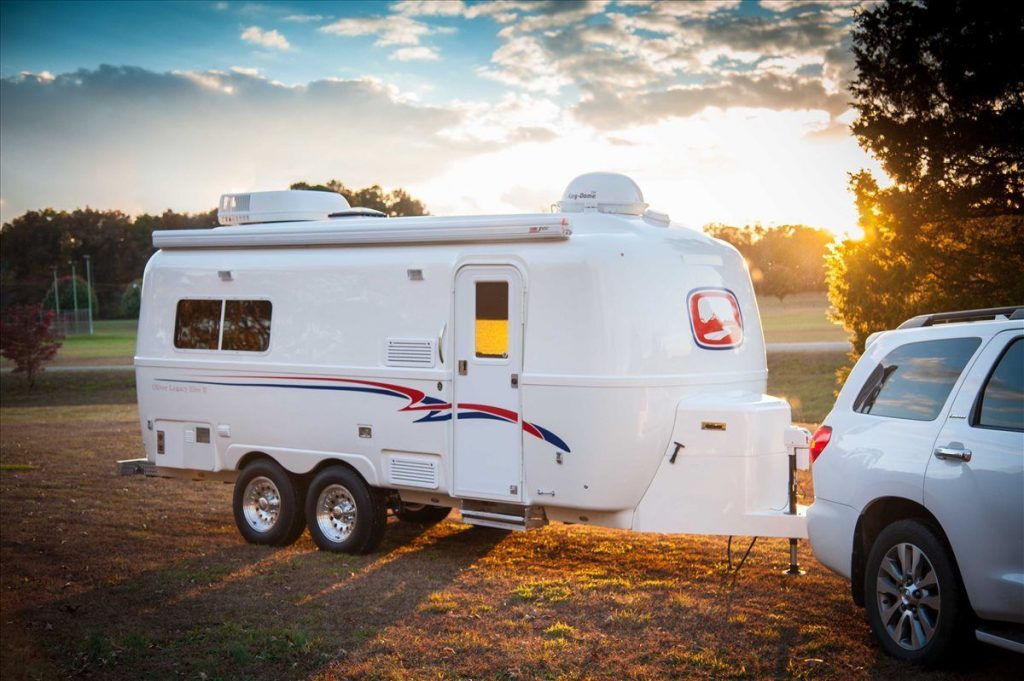
The psi is specified to the tires depending on the weight carrying capacity of a travel trailer. Somewhere inside the vehicle, you will find a label mentioning the maximum psi. The label might be missing in some motorhomes. In that case, check the owner’s manual or contact the dealer to get the right information.
The tire’s sidewall displays ratings including the information regarding the tire pressure. If the tires come with the trailer, then the psi on the sidewall and inside the vehicle will be the same or have a slight difference.

What Is the Correct Travel Trailer Tire Pressure?
How do you know what is the correct camper tire pressure ? There is no definitive answer. Different travel trailers require different tire pressures. Plus, the psi ratings could be different based on the tire types.
What is the average recommended trailer tire pressure ? The tire pressure of most travel trailers remains between 40 and 65 psi. The ratings are for trailers that weigh somewhere from 1,500 lbs to 15,000 lbs. Remember that you don’t have to set the psi at this range. These are just average figures.
How do you choose the psi when the trailer tires say, suppose, max. psi 70lbs? Every tire manufacturer publishes a tire load and RV tire pressure chart . However, not everyone is skilled enough to calculate the precise inflation pressure from the load and psi tables.
The trailer’s front left corner is likely to have a Federal Certification Tag or label, displaying GVWR , GAWR, and tire inflation pressure. This pressure is determined according to the weight of the trailer. This is accurate if the vehicle does not have to carry any extra weight. But this is not possible as the vehicle will carry load and passengers.
The inflation pressure etched on the tire’s sidewall is the maximum amount of inflation for a tire given that it is carrying a full load. The sidewall also carries information about the tire’s max load range.
When the vehicle is not overloaded, the air pressure in the tire should be somewhere between the numbers mentioned on the Federal Certification Tag and the tire’s sidewall. You should never exceed the maximum pressure molded on the sidewall.
To maintain the ideal travel trailer tire pressure , you should ensure that both ends of the axle have the same inflation pressure.
In case if you are replacing an old tire, you should check whether the psi on the new tires is similar to the old ones. Also, the psi of the new tires should not be less than the number mentioned on the trailer’s tag. The tag’s pressure indicates the minimum that the tires should have to carry the trailer’s weight. Pressure lower than that the tires will not be capable of bearing that load. On the contrary, if the psi is higher than the old tires, the trailer may not ride ideally.

Following these tips will help you maintain the right travel trailer tire pressure and avoid accidental over-inflation.
- Never set a tire pressure because another RVer or your neighbor has set it. Two trailers are always different and the tire pressure is related to the vehicle’s weight capacity and the current load.
- Always refer to the owner’s manual when you need to find out the recommended tire pressure and maximum weight capacity.
- Purchase a good-quality RV tire pressure monitoring system for real-time report/warning about tire pressure status.
- Don’t pull a motorhome with under-inflated tires. The air pressure should never be less than the amount needed for the bulk placed on the tires.
- The tires should never have less pressure than what’s mentioned on the certification tag. No matter how heavy a load you are carrying on the trailer, the pressure should be equal or more than the number mentioned on the tag.
- The psi mentioned on the sidewalls indicate the maximum tire pressure. Never inflate the tires more than that recommended pressure.
By understanding the right tire pressure for your travel trailer/RV, you can ensure the safety for your family in RV camping trips !
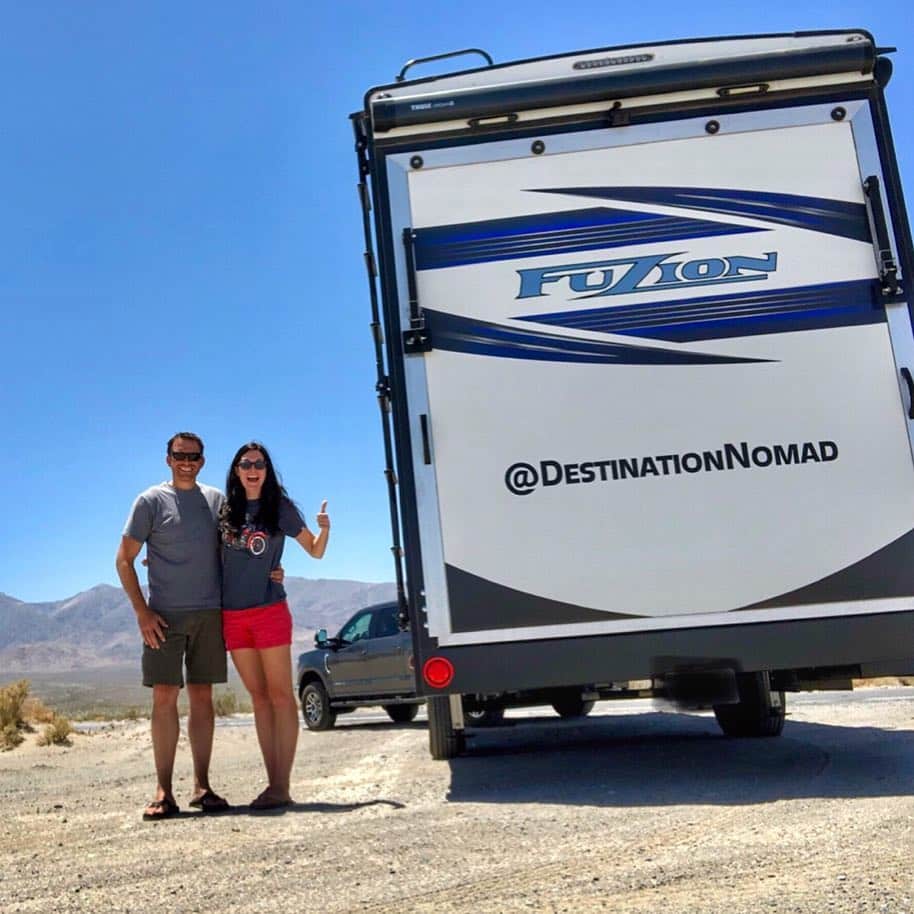
About Chris Coleman
Chris Coleman is an interesting travel blogger and outdoor photographer with a great sense of humor. He owns an RV Accessories shop in New York City so he has the knowledge necessary to provide thorough reviews and give advice on how to choose the right products for RV travel. He puts all that RV knowledge and experience to good use in his sharing posts. Besides product buying guides/reviews, Chris also writes informative articles, how-to articles and RV camping guides in his own interesting viewpoint. Chris’s blog is one of the most reliable information sources for RV campers no matter if you're an expert or a determined beginner.
Related Articles in this Category
The 5 best rv jack stands in 2022 [reviews and buying guide], the best wheel chocks for rv in 2022 [reviews and buying guide], the 10 best truck tires for towing travel trailers & fifth wheels, how do electric trailer brakes work working mechanism, the best tire pressure gauges to buy in 2022, rv leveling jacks will not retract: how to troubleshoot, the 12 best rv jack pads to buy in 2022, best portable 12v air compressors: tire inflator pumps for rvs, best rv leveling blocks: stabilizing & leveling your camper, the 12 best air compressors for rv tires in 2022, knowing how long do rv tires last, the 12 best brake pads for towing 2022, the 12 best rv tires for motorhome, travel trailer or camper, 2 thoughts on “how to set the correct travel trailer tire pressure”.
My RV tire reads ,, ST225/75R15,, on ther side wall it reads 80 max psi,, question: do i have to run them at 80 psi, or can i run them at 65 psi, pros and cons of doing this,, RV weighs approximately 6,650 lbs
You probably need a bit hifher then 65psi, but not the full 80 psi. And so probably, because mostly the 65 psi is yust enaugh fir the weight on tires and 65mph. The E-load 80 psi tire is stiffer, so has smaller surface on the ground, wich has to be compensated by higher pressure to give the same deflection.
For single axle trailer, often the D- load 65psi would need fi 70 psi to give it comfortable reserve, then tge E- load 80 psi would need mayby 75 or 80 psi.
Greatings from an hobby pugheaded Dutch selfddclared tirepressure-specialist( so you can yudge the reliability of my answer.

Leave a Comment Cancel reply
Save my name, email, and website in this browser for the next time I comment.

How Hot Should My Travel Trailer Tires Get
The amount of heat generated by tires depends on the outside temperature and the type of tire.
Tires are composed of rubber, steel, and air. The steel provides rigidity for the tire, while rubber provides cushioning for the vehicle. Air is contained in a tire’s inner tube.
The heat generated by a tire is proportional to its load weight and speed at which it rotates. Tires will generate more heat when they are carrying heavier loads or rotating faster than usual.
What is considered to hot for a trailer tire?
Most experts consider 195 degrees Fahrenheit as the “line in the sand” when it comes to tire temperature: Beyond that point, the temperature will start impacting tire life. At 250 degrees, a tire will start to lose structural strength, could begin experiencing tread reversion and the tire will begin to lose strength. [1]
How hot should a tire be?
How hot does the tire get? Typical tires experience a temperature increase of roughly 50 degrees after running on the highway for a half-hour. If it’s a 70-degree day, this suggests a tire temperature of about 120 degrees. [2]
What tire pressure should I run on my travel trailer?
The tire pressure on an average 16″ RV tire can be anything between 35-80 PSI or 280-550 kPa. [3]
How hot can tires withstand?
Turf is designed to be resistant to extreme weather and climate. As it’s synthetic, turf needs no water, while staying green and soft all year round. Because of this resilience, turf remains undamaged in freezing temperatures, and in hot temperatures, it can withstand shifts of up to 175 degrees. [4]
How do you cool down a hot tire?
If your tires are extremely hot or you don’t want to wait for them to cool down naturally, you can run cold water over them to bring their temperature down. These stops are also a good time to look for any punctures, damage, or other problems. [5]
Is it normal for a tire to be hot?
While it is normal for tires to feel a little warm after driving, they should not feel excessively hot to the touch. If your tires feel hot, they are overheated and potentially close to causing a blowout. Wait until they cool down before you start driving again. Check your air pressure. [6]
Is 5 PSI over too much?
It’s very dangerous whether you drive on an overinflated tire by 5 psi or under-inflated tire. Thus, never forget to check its air pressure regularly, at least twice a month. That is a simple but effective method to help extend your tire life, provide a safe ride, and conserve fuel economy. [7]
Is recommended tire pressure hot or cold?
Tire manufacturers suggest checking tires when they’re cold for the most accurate reading. Outside temperatures can cause tire pressure to vary by as much as 1 psi per 10 degrees; higher temperatures mean higher psi readings. “Tires are black; what does black do? [8]
How long does it take for tires to cool down?
Answer: The rule of thumb is that you need to wait three hours with the car parked before the tires are cool enough to get an accurate pressure reading. In addition, you should try not to drive more than one mile in getting to a pump if you want to recheck the pressure when you add air. [9]
Should I fill my travel trailer tires to max psi?
When it comes to trailer tires you always want to have them inflated to their max psi when cold. Not only do you get the full capacity at the max psi, you also will generate less heat in the tire since there won’t be as much flex in the sidewall, you’ll get better wear and better fuel mileage. [10]
Should I fill trailer tires to max psi?
It’s really important not to overload trailer tires. Overloading tires can cause premature wear and increase the risk of tire failure. The “Max. Load” information stamped on the sidewall indicates a tire’s load capacity when it’s inflated to the maximum PSI. [11]
Do you fill RV tires to max psi?
Never exceed the maximum inflation rating for the wheels/rims or valves when setting the tire cold inflation pressure. Never inflate tires more than 10 PSI above the maximum PSI rating imprinted on the sidewall. [12]
Related posts:
- How Do I Keep My Travel Trailer From Being Stolen
- How Much Does Travel Trailer Storage Cost
- How Often Should You Seal a Travel Trailer Roof
- Where To Buy Used Rv Trailers
Leave a Comment Cancel reply
Save my name, email, and website in this browser for the next time I comment.

What should travel trailer tire pressure be?

- BEGINNERS GUIDE
G. Yoganand
Travel trailer tires are much more critical and should be inflated at right PSI.
But, how do you know the right PSI? We will find out, read on!
Replacing the tires when the thread is gone or when it blows out will cost you few hundred dollars. Inflating the tires to right PSI will enhance the tires life.
Thus, always inflate the travel trailer tires to the right PSI.
What PSI for travel trailer tires
Inflating the tires to correct psi is critical in keeping them in good conditions. So, what’s the correct pressure for travel trailer tires?
No, there isn’t a same answer for all travel trailers. It depends on your travel trailer and the tire.
Ideally, you should set the travel trailer tire pressure to what the sticker inside your rig or the manual mentions unless you changed the original tires with different load capacity. The PSI mentioned on the sidewall of tires is the maximum cold pressure.
The PSI mentioned on the tire sidewall is the maximum pressure it can be set to but you don’t really have to set it to that level unless required.
Setting correct PSI based on your RVs load is critical. Too little pressure can result in sidewall flex resulting in heating which is a common cause of blowouts. Too much tire PSI can result in loosing traction of the travel trailer.
Each travel trailer has maximum weight carrying capacity and on the basis of that, the psi will be specified for the tires. You will normally find the label somewhere inside the travel trailer mentioning the psi that need to be set for the tires.
Apart from the label inside the trailer, a standard sidewall ratings would be present on the trailer tire. If the the tire came along with the new trailer, then at both the places the psi would be same or almost similar with slight difference. When that is the case, its straight forward for you. Just maintain that psi in the tires.
Adding tire pressure monitoring system like this one by EEZ RV is a great investment. Its a multi purpose system that also has anti theft sensors. Its an advanced alert system for your RV that comes with 3 year warranty. It continuously monitors the tire pressure/temperature every 6 seconds.

At times, the label could be missing inside the trailer. You need to contact the dealer for that information or it could be mentioned on the manual as well.
So, what the average psi looks like?
For most travel trailers, the tire pressure is mostly between 40 psi to 65 psi. Remember, this is not what you have to set, its what the average numbers look like. That is, most travel trailer tires will be inflated with PSI falling in this range.
This range is depended on the weight of the trailers as most of the trailer weigh in between 1500 lbs to 15,000 lbs , hence the psi range.
Above point is very critical.
Do not set tire pressure for your trailer tires looking at your neighbor’s travel trailer. Two trailers will always be different, and will have different GAWR (gross axle weight rating) and GVWR (gross vehicle weight rating).
Its simple as that. The only way to find out whats the correct pressure is to look at the ratings mentioned by you manufacturer. In case you do not find those ratings then get your RV weighed and take professional expert advice to figure put the tire pressure.
Finding the right PSI
So, the trailer you have is an old one and its time to replace the tires on it. The label on the trailer has a different psi and the tires you bought are showing psi that’s different.
Now, one thing you should be doing is don’t get tires that has psi lesser than the one mentioned on trailer .
- The trailer manufacturer gives you psi for tires that will be required to carry the trailer weight and any lower pressure would mean the tire wont be in position to take that load. Hence, the psi on your tires shouldn’t be lower than that.
What about higher psi? That happens a lot many times with people. Normally, when you buy a trailer, the tires that are given are just good enough to handle the weight of the travel trailer. Later when you a buy a new tire, that could be rated for higher psi.
So, what do you do in that case? Do you go for the psi mentioned on tires or the lower psi mentioned on the RV manual?
The RV manual or label mentions the psi needed to carry the maximum weight of the travel trailer where as the tires have rating of psi which it can carry max.
So, its better to go for psi mentioned on the tire. This however does not mean that the weight carrying capacity of the trailer would increase. With the higher psi of tires, the trailer may not ride ideal though.
Its also okay to get the psi reduced to what the trailer mentions. It all depends on the psi and the weight being carried. Make sure the psi should not be less than what the RV manual or label mentions though. A lower psi will heat the tires ad result in blowout.
Similarly, setting up higher psi than what the tires are rated for will lead to loosing traction.
Replacing the trailer tires
Normally, a trailer tire would last more around 4-6 years or even beyond .
When you are about to replace the tires, make sure you buy the tires that are of same load capacity .
Having the same capacity is necessary as the trailer would also have many other elements or components that would be designed for that load. This also helps in avoiding the confusion of setting up psi.
When you have same psi written on tires and also on trailer manual, go ahead with that pressure. At times, the psi can be set a little higher to about +5 but not more than 10. Doing that should be avoided. As always do not set the psi lesser than what is mentioned when you don’t go with full load on trailer.
RV professionals or tire experts can also help you through trailer tire pressure charts or trailer tire size charts. But, if you know what tires were originally given for the trailer then go for same brand and rating.
Overloading the trailer
This is one factor that can lead to tire blow out or reducing the tires life over the period of time. Make sure you do not overload the trailer as this will mean your trailer tires wont be able to handle the weight.
The tires are rated for max weight of the trailer. Going beyond that weight limit will mean the psi set in tires wont be capable of handling the weight.
Overloading the trailer not only puts you, your car and trailer in threat but also others on road. A overloaded trailer can slide and turn over, it can collide with other vehicles as well.
Weighing your travel trailer regularly can help you in planning. Not many of us weigh the rv’s regularly and thus we tend to overload the trailer unknowingly. But, that’s not a good practice.
Not inflating the tires correctly
Not setting the tire pressure upto the number listed on the tires or trailer will result in reducing the weight carrying capacity of the tires on trailer.
Under Inflation
The trailer tires need to be inflated enough to handle the top load from the trailer, their sidewalls are designed so. But, with less than specified psi , the tire sidewalls will start generating excessive heat and result in failure.
Over inflating
Similarly, over-inflating the tires of trailer can also result in failures. This leads to wearing out of the tires in the center. But, the end result is same. Thus its extremely important that you inflate the tires correctly.
Another thing to note, as the trailer moves it will heat the tires and the psi may read higher. So, the bets practice is to check the tire pressure when its cold. Early in the morning when you haven’t taken it road is a good time to do this activity.
Its always a good practice to check the tire pressure before making a long travel. Make sure you do this during morning time as the tires will be cold and thus give accurate psi.
What tires for trailer
Buying a tire for a car and buying it for trailer is completely different. Tires for trailers are specially designed and you would see text “ST” written on their sidewalls. ST stands for special trailers, they have strong sidewalls. And, this makes them good enough to handle the vertical load.
Different companies like goodyear, michelin and many other make quality tires for travel trailer. Selecting the right tire is critical and hence check twice before buying a new one for your trailer or even fifth wheel.
Apart from proper inflation
While maintaining the tire pressure is the most important aspect of keeping trailer tire good. Lets, check on other pointer to be given similar attention. This tips will definitely help in increasing the life of trailer tires.
1. Check sidewalls
Before you start that camping travel make sure to check the tire sidewalls. Identify cracks or breaks before you go on road. Its important that you have perfectly fit tires and not take any chance whatsoever. Doing such inspection should be in your travel checklist.
People often overuse their tires on RV’s or camper. Replacing tires on time should be your priority. Normally, the tires go out of use in around 4-5 years and thus keeping track of them is necessary. Also, at times you may not be able to make out if the tire is still good or not. In such cases take the trailer to a professional and get the tires inspected.
Remember, a blow out in the middle of road is more dangerous and is also costly. A trailer that fails on the middle of road need to be towed to a repairer. And that can be costly and tedious job. You surely don’t want that to happen to you.
2. Extra weight on trailer
Maintaining pressure as per the laid out value is necessary to support the weight while towing a trailer. The manufacturer gives the psi value for max pressure that trailer handle.
Exceeding the stipulated weight will mean the tires wont be able to tackle the weight. And this can result in anything. Remember, even few pounds of extra weight can lead to incidents. Make sure you weigh the trailer properly and keep the weight within limits.
When going out for long travel we often pack unnecessary items. This leads to weight that goes out of the limit. Keeping a proper checklist and avoiding elements that are not needed can help in checking the weight.
3. Tire care during storage
While the travel trailer camper is in storage, there is good chance of damage too. Make sure the tires are protected well. You can make use of tire covers for this. Also keeping the tires above ground can help relive pressure on them.
Keeping them without covers will also affect the tires due to UV radiation and or moisture. Also, during winter times its necessary that the whole trailer is well stored else you may have hard time getting it out next season.
Similar care is also needed in other towable RV’s like pop up camper or tent trailer as well as in motorhomes like class C RV or class A. RVs need special storage during winters.
4. Replace on time
Getting the tire replaced on time is necessary. With limited life, you better replace them before a blowout happens. Else, the impact could be worse. Doing period checks on sidewalls, checking for wear and tear can help a lot in deciding.
A scheduled maintenance of the trailer can take care of this aspect. Also, make sure you put tires that have same rating and capacity. Many a times you get tires that aren’t the same and that creates confusion about psi as well.
Its better to go for tires that manufacturer recommends. Whether you have a jayco or a airstream travel trailer or a winnebago RV, its all similar for all, you need to take good care and replace the tires on time.
You Might Also Like

How To Mount TV in RV (Mount Types and Setup Steps)

Average cost of Travel trailer, Class C RV and Class A RV

How To Keep Your Travel Trailer Warm In Winter
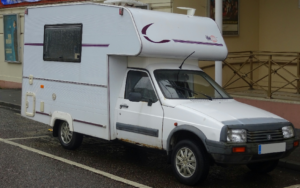
Ultimate Guide to Small RV Rental

- You are here:
- Home »
- Blog »
- » Tire Pressure On Travel Trailers: What Should The Pressure Be?
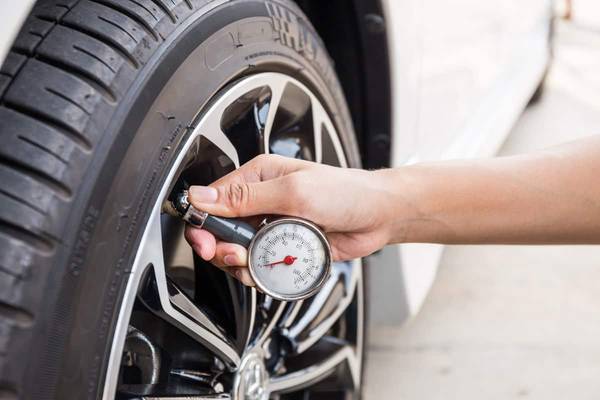
Tire Pressure On Travel Trailers: What Should The Pressure Be?
- April 20, 2022 /
- By James V.
Tire pressure is an influential factor for gas mileage, tire wear, and other important travel details. You need the right tire pressure to make sure you are not overworking those tires and ruining them before their actual lifespan is up.
You will get a lot of different opinions on how you should inflate your trailer’s tires. The ideal tire pressure will depend on the size and type of trailer you are towing. However, that pressure should be within 40 to 65 PSI no matter the trailer brand, size, or model.
To learn more about this important topic, just continue to read our article. It has the information you want to know about so you can set your trailer’s tires to the right air pressure level. Take a few minutes to see how this important information can help you out on your next vacation.
Should You Fill Travel Trailer Tires To Max Psi?
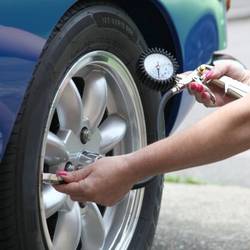
There is an ongoing debate about this specific topic. If you read the different RV discussion forums, you will find that there are people on all sides of the issue. Some say you should put the maximum amount of air in your tires while others are saying not to.
What compounds the confusion is that the PSI listed on the side of your tires is an average figure. There is no definitive answer for the correct tire pressure for your or any trailer because all trailers are different.
There are some very qualified people who say there is nothing wrong with filling your tires to the maximum level that is listed on the side of your tires. The problem comes in when you are not wary of the different trailer tire types.
They may be the same size but some tires are Load C, others are Load D and still, more are for Load E. Those are the different categories, or some of them, that come into play when you are buying tires and wanting to find the correct tire pressure.
Different tire types require different PSI levels.
What Should The Tire Pressure Be on a Travel Trailer?
As we just said, there is no definitive tire PSI for all trailers. Each trailer will require a different amount of air pressure. This level is determined by trailer weight, size, axle rating, and trailer tire type.
You should be cautious about using the PSI your friends or any YouTube personality claims to be the perfect tire pressure. That level they claim works for them may only work for them. Since your trailer is different from theirs, you may need a different PSI level for your trailer.
You can check the sticker that is supposed to be inside your trailer or the information listed in your owner’s manual. Those two items should give you the right PSI for your trailer and its weight. The side of the tire will also give you the maximum PSI level that you can fill the tires too.
The problem that comes in, is if you underinflate your tires, you could be asking for trouble. Under inflation is not your friend and depending on the trailer, etc., your tires should be inflated to somewhere between 40 and 65 PSI.
How To Determine Trailer Tire Pressure
It is said that every tire manufacturer produces and publishes a tire pressure chart and includes tire load stats as well. However, this is not a simple chart to read for many people. You can try using it but there is a simpler way.
On every trailer, there is supposed to be a federal certification tag on the trailer’s front left corner. On this tag is listed the trailer’s GVWR, GAWR, and the tire pressure information. That tire pressure information is calculated by the trailer’s weight.
It is an accurate calculation and it is only thrown off if you put an extra weight inside or on the trailer. When the trailer is not loaded with cargo and supplies, the tire pressure should be somewhere between what the tag says and what the maximum PSI is listed on the side of the tire.
However, you are not to exceed the maximum PSI listed on the side of the tire at any time. When replacing the tire, the maximum PSI should not be smaller than the PSI listed on that tag.
Trailer Tire Pressure Calculator
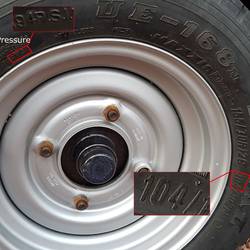
A quick search on the internet using this sub-section’s heading will result in a lot of tire calculators. The problem is that these tire calculators may not work for trailer tires. The Firestone option was for agricultural machinery and not good for trailers.
Others focused on cars and trucks and made no mention of trailer tires. There are some websites that are strictly for figuring out PSI for different trailer tires. One is more for European or Australian trailers and you can look at it here .
Another is a simple chart for North American trailer owners. You can take a look at it at this link . There is also a website that teaches you the equation you need to use if you do not want to use the calculators on the internet or you are not near a computer.
You can find his detailed explanation and equation at this link . Do your own search to see if you find some tire pressure calculators that you like better. The major tire makers should have some listings for trailer tires you can use.
Travel Trailer Tire Pressure Chart
You will find that the different tire makers will have tire charts for the tires they make for trailers and RVs. It is the same principle as the previous section and you can find these charts by using the sub-section’s title as your search words.
These charts classify the tires by wheel diameter and then make a table with the PSI listing as the main heading. They will also give you the load amount for each tire so you can get an accurate figure and know how much PSI you need to put inside your tires.
To look at Michelin’s tire chart for trailers and RVs, just click on this link . For Toyo Tires, just click on this link
. For your specific tire brand, you should look up the company’s website or use it in your search terms.
Every company may have different figures for your trailer tire PSI levels and it is best to check your brand of tire out on their website or contact them directly if you can’t find it.
Trailer Tire Pressure Cold vs Hot
Once you learn the difference, you will see how practical and sensible those words are. A cold tire has sat all night and has not been used yet for the day. A hot tire has been used for some time throughout the day.
The latter describes the tire after it has been warmed up by use and the ambient temperature levels. A hot tire will show between 4 to 6 higher PSI than a cold tire will show. The rate is about 1 PSI pound per 10 degrees ambient temperature.
But the key is you cannot inflate your tires according to the hot levels. If you over or under inflate your tires you will cause some damage to the tires and make your journey a bit rougher than it should be.
No matter the conditions you are driving under, you cannot inflate your tires past the cold PSI maximum level listed on the side of the tires. If you violate that level you can overheat your tire and overheating is the leading cause of trailer tire failure.
Trailer Tire Pressure Loaded or Unloaded
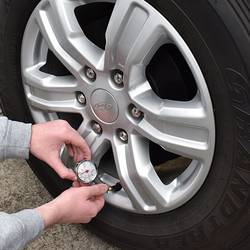
The good news here is that the tire PSI does not change when the trailer is loaded or not. You may see a difference in the shape of the tire if you overload it but the PSI will not change just because the shape changes.
In what may be called extreme circumstances, you may see a 1 PSI change but that is not enough to damage your tires. The key is not to exceed the PSI level listed on the tire. That is the maximum amount of air you can place in your trailer tires.
The reason some people may lower the PSI in their tires is that their trailer is empty and they want to stop the bouncing that comes with properly inflated tires. Do not confuse the load range with the PSI level.
The former is for how much weight the tire can hold and the latter is telling you how much air you can put i n the tire.
Double Axle Trailer Tire Pressure
This is not going to change. Each tire, no matter the number of axles, will have a maximum amount of air it can hold. That maximum amount is listed on all the tires. You do not go over that PSI level even if you have 4 tires and two axles.
Of course, some people say that if you under inflate your tires when carrying a load, they will grip the road better. This is not the case. Under inflated tires may cause you tire trouble in different ways and make it more dangerous to drive. The same warning applies to over-inflated tires.
Just do not go over the PSI level listed on the tire and you should be fine. The weight held by each tire is not a factor in this issue and it is usually not known how much each tire is carrying. Stick to the PSI level on the side of the tire and you should ward off any problems even if you bounce more.
How To Check Trailer Tire Pressure
This is a simple step to take. If you take the time to check your tire pressure before you leave your home or camping spot, you can save yourself a lot of trouble. All you need to check your tire pressure is an accurate tire pressure gauge.
Take the covers off the valve and press the gauge down hard and firm onto the valve. The result spurt of air will push the needle or white gauge to the level of air pressure inside your tire. If you have a digital tire pressure gauge then you should get a clear read-out.
Then check your reading with the PSI level listed on the side of your tire. If the two do not agree, you may have to add more air or let a little bit out. However, take into account that warm tires will read higher than cold tires.
So you want to adjust for the different reading. It is best to check your tires when they are cold as the PSI level on the side of the tire is set for cold tires.
What Should Boat Trailer Tire Pressure Be?
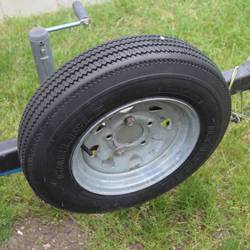
The answer is going to be the same for this type of trailer as it is for regular travel trailers. The maximum amount of air you should put in a boat trailer tire is listed on the side of the tire.
It doesn’t matter how heavy the boat is, that is the most air you can put in a boat trailer tire or any trailer tire. There is nothing scientific or special about tires no matter where they go. They can only hold so much air pressure and that is it.
Over inflate or under inflate those tires and you will face the same risks and dangers travel trailer and other trailer owners face.
What Should Tractor-Trailer Tire Pressure Be?
This is the same answer as the previous section. Whatever is listed on the side of the tire will be the most air you can put inside the tire and have it perform up to its claims. At no time can you go over that listed PSI level even if you are hauling your crop in from the furthest field from your barn or silo.
The tires are made to hold only so much air and if you go over it, you will have some sort of trouble eventually. While tires are made to handle different loads, their PSI capacity does not change.
You have to look on the side of the tractor-trailer tires and see how much air pressure it can hold. This holds true for the semi-trailers you may be driving. The capacity does not change when the load weight changes. Read your tire to get the maximum PSI level no matter what.
Why are Trailer Tire Pressures So High?
The basic reason is that trailer tires have to hold more weight than a passenger tire has to hold. Sometimes, those trailers can weigh up to 15,000 pounds and they need a lot of air to hold that weight and move down the road
A passenger vehicle may only hold between 2000 and 8000 pounds, depending on if it is a small car, sedan, light truck, or SUV and carrying cargo. Also, the trailer tire is built with thicker sidewalls so they can hold more air with ease.
The lighter the trailer, the less PSI you will need in the tires. The maximum tire pressure is determined by the weight of the trailer so you may find that lighter trailer tires may not hold as much air as their heavier counterparts.
Will Low Tire Pressure Cause Trailer Sway?
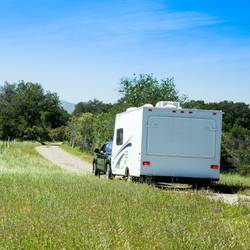
Yes, that is one of the many sources why trailers sway as you drive along the road. The tires are said to compress and decompress with each bump in the road. This reaction influences the trailer’s performance and you should start to see some sway taking place.
Low or under inflated tires give a lot more freedom of movement to the tires and that means you are losing control over your trailer. When you see your trailer swaying, take the next opportunity you can to check the tire pressure .
If they are inflated to the right level then you need to start looking at other sources for this problem. Those other sources would include too much weight, the weight is not distributed properly, you are experiencing wind gusts or you are driving too fast.
The maximum speed trailer tires are rated for is 65 mph and some are rated for lower speeds.
Some Final Words
Having the right air pressure in your tires is very important. Too little or too much can result in damage to the tires, make them wear out faster, or an accident. No matter how much weight you are carrying, the PSI levels never change.
What it says is the maximum tire pressure for the tire, you cannot exceed that level no matter what. It doesn’t matter what anyone says either. Do not go above that PSI level.
Related Posts
How Long Do 22.5 Tires Last? (Truck Tire Life Expectancy)
Are Freedom Hauler Tires Any Good? (Trailer Tires Reviews)
Best Tires For E450 Motorhome (Tire Size and Pressure)
Leave a Comment:
Nearest Store
- (907) 202-7405
- Get Directions
- Store Details
Mon-Fri: 8:00 AM - 6:00 PM
Sat: 8:00 AM - 5:00 PM
Find Another Store
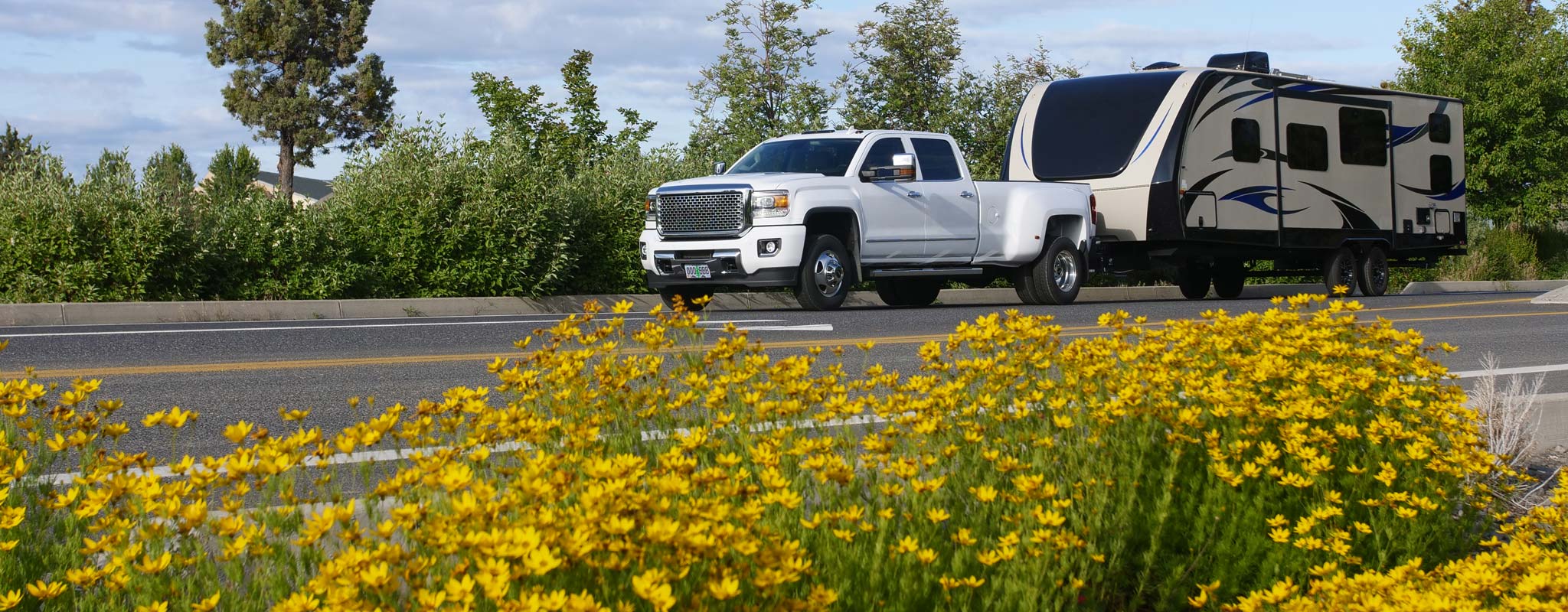
How To Choose the Best Tires for Your Trailer
Having the right set of tires on your vehicle is essential for any road trip, but so are the tires on your trailer, whether you’re pulling a camper, fifth wheel, boat, or utility trailer. To help you avoid issues and pick the right tires for your needs, we’ve compiled some quick trailer tire tips.
Need New Tires for your Trailer? Come to Les Schwab
Anytime you buy a new or used trailer, bring it to your local Les Schwab . We’ll check the tire air pressure, the torque on the lug nuts, double-check your spare, and give the wheel bearings an inspection. The pros will also show you what you need in your vehicle to change a flat tire on an RV or trailer when you’re on the road. If you’re interested in a set of custom wheels or specialized tires for your trailer, we can show you plenty of options.
Some trailers, new or used, don’t always come with a spare and/or may require specialty tools for installation. For free advice, stop by your local Les Schwab .
You Have Choices
Depending on the trailer, you may be able to find LT (Light Truck) tires that work. This can help with aesthetics if you want your trailer tires to match the ones on your tow vehicle. Or you can simply stick with ST (Special Trailer) tires, which include radial and bias construction options.
Choose the Right Trailer Tires for Your Needs
Whether you’re hauling a boat, camper, or livestock, it’s important the tires you choose match the weight capacity of your trailer, provide heat distribution to avoid tire failure, hold up to highway speeds, and provide stability.
Boat Trailer Tires
Travel and fifth-wheel trailer tires.
At Les Schwab, we carry tires for fifth-wheel trailers, bumper-pull trailers, pop-up campers and more. The professionals at Les Schwab can help you decide between ST (Special Trailer) tires and LT (Light Truck) tires, depending on your needs, what you drive, and what you’re towing. While LT tires can be used to match what is on your tow vehicle, ST tires offer improved fuel economy with shallower grooves, improved stability and reduced swaying at highway speeds.
Utility/Livestock Trailer Tires
Whether you’re taking your favorite critter, UTV, ATV, snowmobile, or dirt bike out for the weekend, or you use your utility trailer for work, Les Schwab can help you decide on the right trailer tires.
The Difference Between Radial and Bias Construction Types
Trailer tires come in many sizes. These include radial and bias. Each of these perform differently. Radial tires are constructed with belts running at a 90 degree angle of the tread centerline.
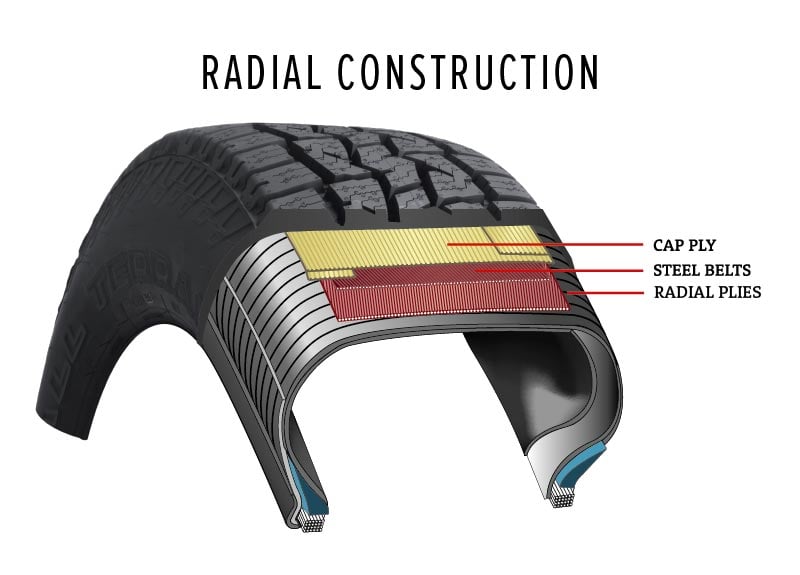
Radial tires tend to last longer overall and are less likely to develop flat spots when parked for extended periods of time (some trailers are parked over the winter). Radial tires perform well at highway speeds, dissipate heat better, and offer lower rolling resistance for a smoother ride.
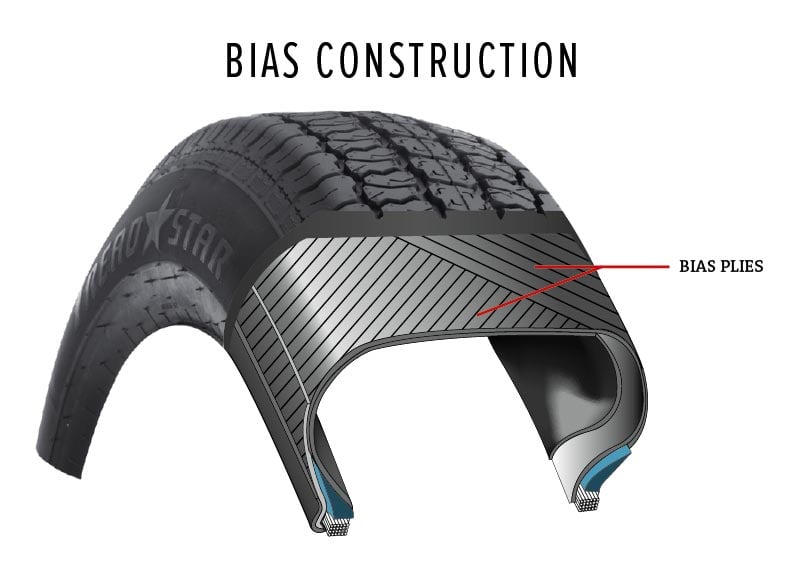
Bias ply tires are constructed with belts running at a 30-45 degree angle of the tread centerline. While bias sidewalls can offer stiffness to reduce trailer sway and increase stability for specific needs, bias ply tires may be limited in availability. Today’s standard trailers often perform better overall with radial tires.
Les Schwab Tip: Whether you choose radial or bias tires, stick with the same type, size, and load range on all wheel positions on your trailer.
Know Your Trailer and Tire Limitations
Check your trailer for its weight capacity. This number will be based on its axle rating. Increasing your tire load-carrying capacity does not increase the weight-carrying capacity of your trailer. If you stay within its load capacity, you’ll reduce your chances of an issue – especially if you are using the proper tires. See the example below.
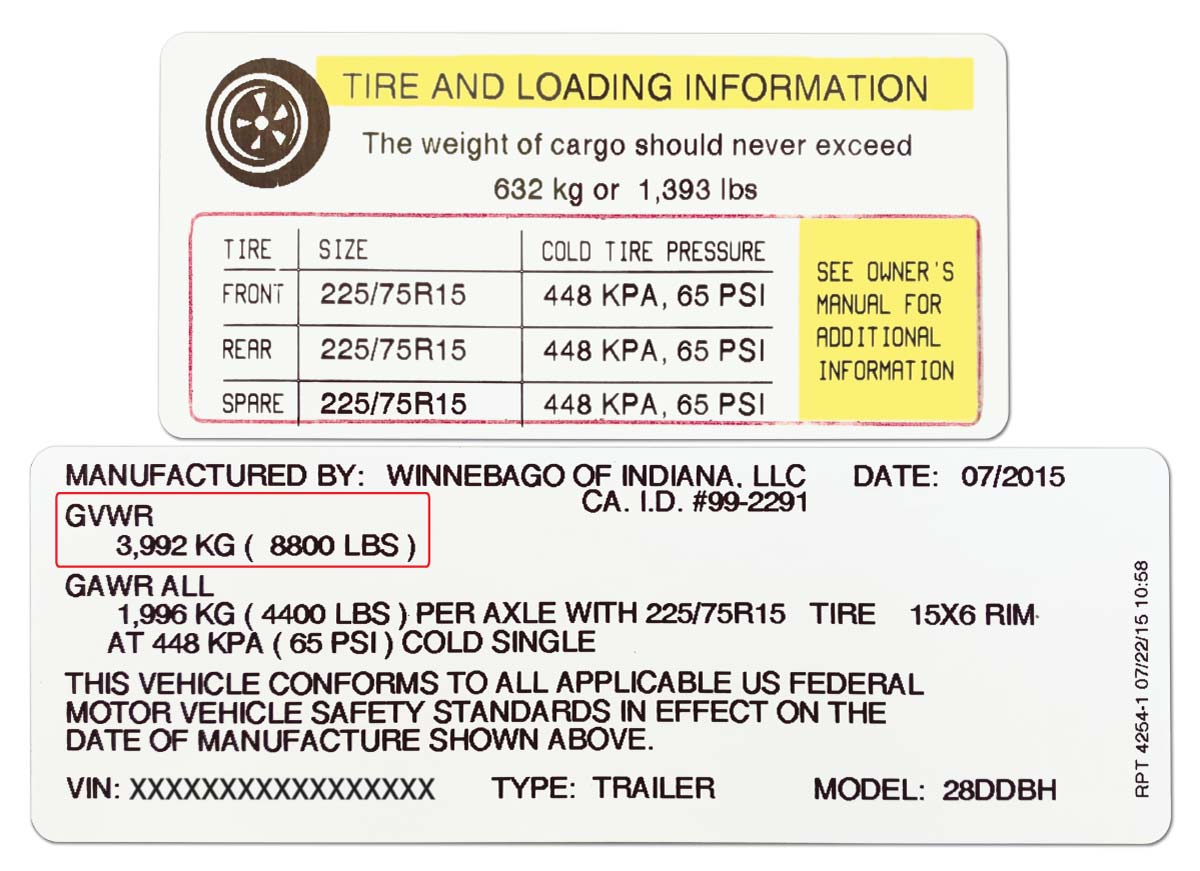
Be sure the tires on your trailer meet or exceed the trailer’s GVWR (Gross Vehicle Weight Rating, which is the trailer’s maximum operating weight, including cargo) shown above.
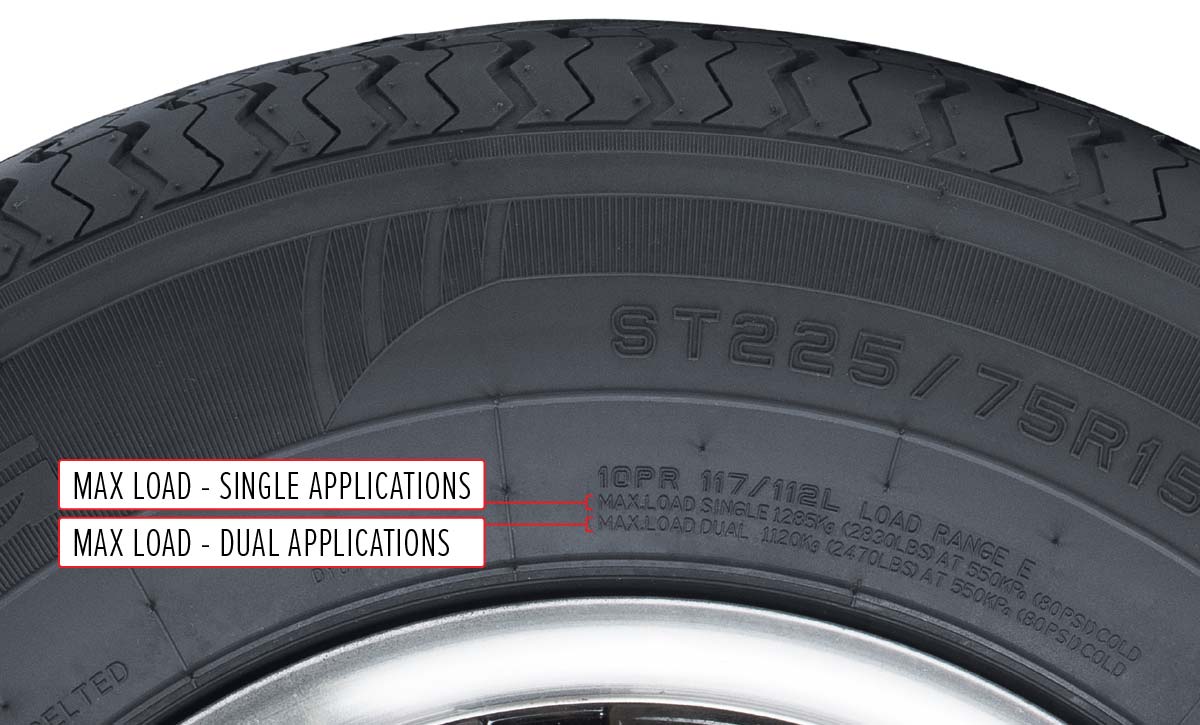
The maximum load (carrying capacity) is only met when trailer tires are inflated to their maximum pressure. When tires are underinflated, it will decrease the load-carrying capacity and the speed they can travel. Never exceed a tire’s maximum air pressure.
Les Schwab Knows Trailer Tires
Stop by your local Les Schwab. Our team will help you choose the best tires for your trailer . They’ll also take a look at the overall condition of your current trailer tires, check for cracks around the valve stems, top-off your tire pressure, and show you how much life is left in those tires before you head out on your next outdoor adventure.
Find Your Store

How Warm Should Trailer Hubs Get
Trailer hubs should be warm to the touch, but not hot. If they are too hot to comfortably keep your hand on them, then they are probably too hot and need to be cooled down.
If you’re wondering how warm trailer hubs should get, the answer may surprise you. While it’s true that they shouldn’t get too hot to touch, there is no definitive answer as to how warm is too warm. Hubs are designed to dissipate heat, and as long as they’re not getting too hot to touch, they’re likely operating within normal parameters. However, if you notice that your hubs are consistently getting very hot, it’s important to have them checked out by a professional to ensure that there isn’t a problem.
Ask the Expert – What’s the normal operating temperature for trailer wheel bearings and the limits?
Semi Trailer Hub Temperature
As a semi-trailer truck driver, you know that one of the most important aspects of your job is to ensure that your rig is in good working order. That means regularly checking things like your tires, brakes and lights. It also means paying close attention to your hub temperature. What is the ideal hub temperature for a semi-trailer truck? The answer may surprise you – it’s actually lower than you might think. According to industry experts, the ideal hub temperature for a semi-trailer truck should be between 130 and 140 degrees Fahrenheit. Anything above that range is considered too hot and could lead to problems down the road. There are a number of factors that can affect your hub temperature, including the type of trailer you’re hauling and the amount of weight it’s carrying. If you’re hauling a particularly heavy load or traveling in hot weather, it’s important to keep an eye on your hubs and make sure they don’t get too hot. If you notice that your hubs are starting to get too hot, there are a few things you can do to cool them down. First, try reducing your speed. This will help minimize friction and heat build-up. You can also open up your trailer doors or windows to help improve airflow and cooling. Finally, if possible, pull over and stop in a shady spot until your hubs have cooled down to a safe range.
New Wheel Bearings Getting Hot
If your new wheel bearings are getting hot, it’s likely because they’re not properly lubricated. The heat generated by friction can quickly damage the bearings, so it’s important to take care of the problem as soon as possible. One way to tell if your bearings are getting hot is to feel them with your hand. If they’re too hot to touch, that’s a good indication that something is wrong. You can also check for visible signs of damage, such as discoloration or melting. If you suspect that your bearings are getting hot, the first thing you should do is check the level and condition of the lubricant. If it’s low or dirty, topping it off or changing it may solve the problem. You should also make sure that there’s no debris blocking the bearing from moving freely. If your bearings are still getting hot after taking these steps, you may need to replace them entirely. Be sure to consult with a qualified mechanic before making any repairs yourself.
Trailer Hub Temperature Monitor
If you’re like most RVers, you’ve probably had the experience of arriving at your destination only to find that your trailer’s brakes have seized up from sitting in the heat. Or maybe you’ve been on the road for a while and noticed that your trailer’s tires are starting to get hot. Either way, it’s not a pleasant experience. A trailer hub temperature monitor can help prevent these problems by keeping an eye on the temperature of your trailer’s hubs and brakes. Most models are designed to be installed inside the wheel well, where they can take readings without being obstructed by debris or other objects. Most monitors will give you both an audible and visual alert when the temperature reaches a certain threshold. Some even come with wireless capabilities so you can check on the status of your trailer from inside your RV! No matter what model you choose, a trailer hub temperature monitor is a great addition to any RVer’s toolkit. Not only will it help keep your brakes in good working order, but it can also save you from costly repairs down the road.
How Hot Should a Trailer Tire Get
One of the most common questions we get here at Trailer Tire Engineering is how hot should a trailer tire get? The answer, unfortunately, is not as simple as it may seem. While there are some guidelines that can be followed, ultimately it depends on a number of factors specific to your situation. To start, let’s dispel a couple myths about trailer tires and heat. First, the notion that running hotter tires will make them last longer is simply not true. In fact, running your tires too hot can actually shorten their lifespan considerably. Second, while it’s true that underinflated tires will run hotter than properly inflated ones, overinflating your tires is also not a good idea. Not only will it decrease the tire’s footprint (and therefore its load capacity), but it can also lead to uneven wear and increased heat build-up. So what are some general guidelines to follow when trying to determine how hot your trailer tires should get? First and foremost, you should check with the manufacturer of both your trailer and your tires. They will have the best insight into what temperatures are safe for their products. Additionally, take into account factors such as ambient temperature, inflation pressure, speed and load when making your decision. And finally – don’t forget the golden rule of tire safety: if in doubt, pull over and let them cool down!

Credit: www.ebay.com
Is It Normal for Trailer Hub to Get Hot?
If you’ve ever felt your trailer hub getting hot while you’re towing, you’re not alone. It’s actually quite common for trailer hubs to get hot, and there are a few reasons why this happens. First, it’s important to understand how trailer brakes work. When you press the brake pedal in your tow vehicle, a hydraulic system activates the brakes on your trailer. This system relies on friction to create the stopping force, and that friction creates heat. So it stands to reason that the hotter the braking surfaces are, the hotter the fluid in the system will get. Secondly, most trailers have electric brakes which use an electromagnetic field to activate the brakes when you hit the brake pedal. These electric brakes also generate heat as they work. So what can you do to keep your trailer hubs from getting too hot? First, make sure that your tow vehicle is properly equipped with a good cooling system for its own brakes. Secondly, if your trailer has electric brakes, make sure that they are properly sized for your application and that they aren’t working harder than they need to by using a brake controller with adjustable settings. Finally, be sure to give yourself plenty of space to stop so that you don’t have to rely heavily on your brakes and cause them to overheat.
How Do I Know If My Trailer Bearings are Too Hot?
One of the most important maintenance items on your trailer is to keep the bearings greased and in good condition. The bearings allow the wheel to rotate smoothly, and provide support for the weight of the trailer. If the bearings get too hot, they can fail, leading to a dangerous situation. So how can you tell if your trailer bearings are too hot? There are a few signs to look for: 1. Your trailer feels like it’s dragging or not moving as freely as usual. This could be because the bearings are starting to seize up from heat. 2. You see smoke or smell burning coming from the area around the wheels. This is a sure sign that something is wrong and needs to be fixed immediately! 3. The wheels feel unusually hot when you touch them. Again, this could indicate that the bearings are overheating and need attention. If you notice any of these signs, it’s important to take action right away. First, check the level of grease in the bearings – if it’s low, add more until it reaches the full line on the bearing cap (don’t overfill). Then, drive slowly and carefully to a safe location where you can inspect further – don’t continue driving if there’s any risk of damaging the wheels or causing an accident!
What is the Normal Operating Temperature of Trailer Bearings?
Trailer bearings are designed to operate at high temperatures, typically between 100 and 130 degrees Fahrenheit. However, prolonged exposure to temperatures above this range can cause premature bearing failure. For this reason, it is important to regularly check trailer bearings for excessive heat build-up. If bearings become too hot to touch, they should be replaced immediately.
The conclusion of this blog post is that you should not let your trailer hubs get too hot. If they do, then you could potentially damage your bearings or have other problems. It is best to keep an eye on the temperature of your hubs and make sure that they do not get too hot.
Leave a Reply Cancel reply
Your email address will not be published. Required fields are marked *
Save my name, email, and website in this browser for the next time I comment.
- Replace travel trailer tires
How Often Should You Replace Your Travel Trailer Tires?
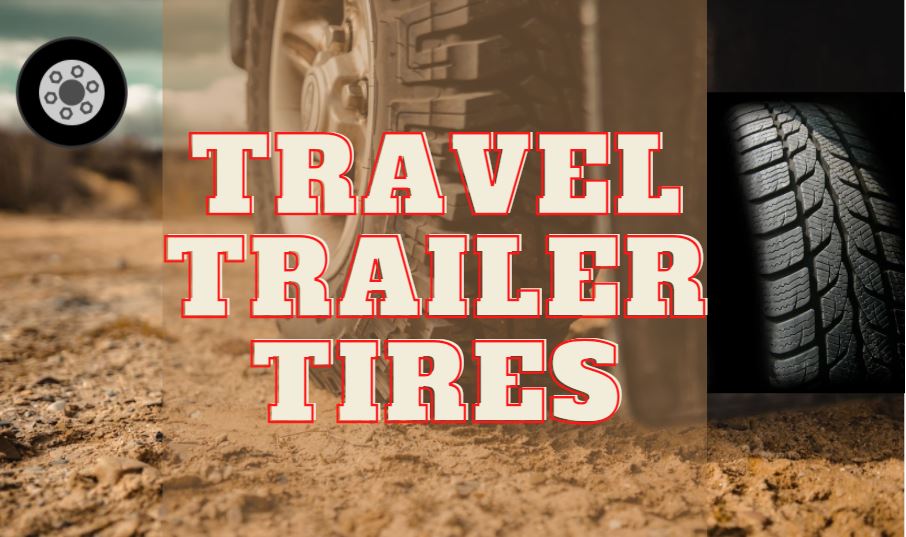
It goes without saying that one of the most essential parts of a travel trailer is its tires. To hit the road and ensure a safe journey, it’s vital to do a quality check of the tires. However, we often forget to check the condition of the tires of our travel trailers, and that’s why we often get in trouble for changing the tires in the middle of the journey.
Therefore, if you have a travel trailer, it’s crucial for you to know how often should travel trailer tires be replaced.
Well, generally it’s better to change the trailer tires every 3 to 6 years. Apart from that, how often should you change tires on a travel trailer depends on a number of important factors, which we’ll discuss in this guide. If you want to know exactly how often to replace travel trailer tires read on this detailed guide.
How Often Should Travel Trailer Tires Be Replaced
If you are a travel enthusiast, lightweight travel trailers come in really handy and also fit every traveler’s needs perfectly. And when it comes to travel trailers the name of the tires comes automatically. As it is one of the most essential parts of it which helps to carry the entire weight of your travel trailer.
However, to ensure that these tires do not endanger your journey, you need to make sure that they are in good condition. They should be replaced before their life ends. So, here’s how often should travel trailer tires be replaced.
In general, you should change the tires of the travel trailer every three to six years depending on the following factors. So, the following are the factors that will help you to understand how often should you replace travel trailer tires.
- Tread Depth
The tread on your trailer's tires gives the gripping action and traction to prevent the tires from slipping on the roads, driveways, and more. You should replace the tires when you see that your tire tread is worn down to 4/32 of an inch. Also, if you drive about 10,000 to 15,000 miles a year, the trades will get damaged. A thin tire has the risk of blowing out on the highway & it could be dangerous.
Each tire manufacturing company will have different recommendations about tire life. A travel trailer tire’s life doesn't start from the day you purchase it. Its life starts from the day the manufacturer produces it. So, before buying a travel trailer tires see when it was manufactured. The date is given on the tire’s body.
On average, a travel trailer tire’s life cycle is about 3-6 years under normal use and good maintenance. But, if you use the travel trailer frequently, the tires will start to lose their life earlier than a trailer that is rarely used.
Mileage is one of the most important factors that you should consider. The lifespan of a travel trailer tire does not only depend on the number of years, but it also depends on the mileage. RV tires should be used for about 5000-12000 miles. It may hit the miles limit earlier than 5 years. If you cross the miles limit, you may blow out on the road. So it should be replaced before the miles limit ends.
Your RV tires are made with a thicker sidewall so that they can handle the weight properly and maintain the right amount of inflation. If the tires are underinflated, they could generate extra heat & could be very dangerous while driving.
Therefore, it’s crucial to ensure that your RV tires are properly inflated. The right amount of PSI increases fuel efficiency, prevents tire blowouts, and slows down the tire aging process. So take out that pressure gauge before each trip and check the PSI level. The maximum PSI level of your RV tires is located on tire sidewalls.
- Crack, Puncture, Or Foreign Objects
Crack, puncture, and foreign objects are usually responsible for creating spaces that allow the air to escape from your tire. If you don’t notice them immediately, they could lead the tires to be blown out on the road. So, when you notice any of them, you should replace the tire.
So, make sure to consider all these factors to decide if your tire needs a replacement or not. And if the age of your tire goes beyond 5 to 6 years, it’s crucial to have them replaced otherwise, it can be dangerous for you.

Stay updated with our newsletter
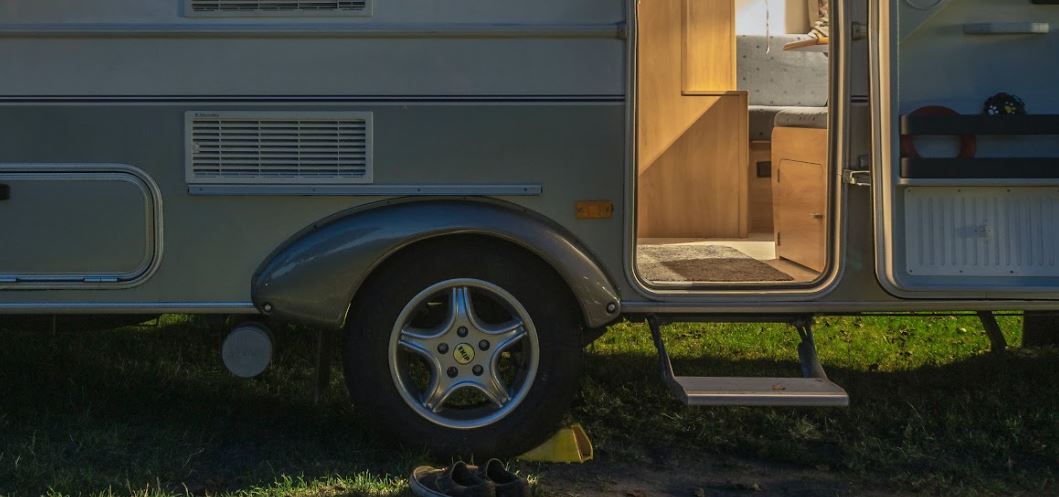
Tips to make tires last longer
Once your tires hit the 5 to 6-year mark, there is nothing much that you can do to maintain them except the replacement. But, there are some maintenance tips that you can follow from the beginning, to prolong the life of your RV tires. So, here are some maintenance tips for you all-
- Try to keep the tires always clean using mild soap and normal water.
- Keep them properly inflated to the maximum cold pressure level (recommended)
- Always cover the tire when not in use in order to protect them from ultraviolet sunlight.
- If you’re parked or storing your travel trailer for extended periods of time, make sure to take the weight off tires.
- Also, for long-term storage, you can consider removing the tires and wheelsets completely.
- When the tire sits idle, make them rotate occasionally.
- Keep them away from wet ground, otherwise, they can absorb the water
- Never forget to check the tires when you have planned for a long trip. Go ahead and replace them if you have any doubt
Final Verdict
It doesn’t matter if you’re a full-time or weekend traveler, if you have a travel trailer, you should keep your eyes on its tires. It’ll ensure your safety as well as a hassle-free and great adventure experience
Remember, trailer tires are not something to be taken lightly. You must know how often should travel trailer tires be replaced to make sure your tires are all set for road use. We hope this guide helps you to get a clear answer regarding this topic. So, if you’re planning for a tour make sure to consider this guide.
About Author:

Hi, I'm Kevin Pommells, a lover of camping and the great outdoors as everyone says nowadays. I'm also a passionate soccer fan and the proud owner of CamperRules.com, a website dedicated to helping campers and outdoor enthusiasts make the most of their adventures. With years of experience exploring the wilderness and a deep love for the sport of soccer, I'm always looking for new ways to combine my two passions and share my knowledge with others. Follow me for tips, tricks, and insights on all things camping and outdoor recreation.
Follow Me @ Twitter | Facebook | KevinPommells.com
As an Amazon Associate I earn from qualifying purchases.
We are a participant in the Amazon Services LLC Associates Program, an affiliate advertising program designed to provide a means for us to earn fees by linking to Amazon.com and affiliated sites.
- How to Tie a Tie
- Best Coffee Beans
- How to Shape a Beard
- Best Sweaters for Men
- Most Expensive Cognac
- Monos vs Away Luggage
- Best Luxury Hotel Chains
- Fastest Cars in the World
- Ernest Hemingway Books
- What Does CBD Feel Like?
- Canada Goose Alternatives
- Fastest Motorcycles in the World
The Manual may earn a commission when you buy through links on our site.
Hitch up with the 7 best off-road trailers ready to take you anywhere in 2024
Beefy tires, rugged shells, and serious overlanding chops—these trailers go where most others won't dare.

From 4×4 camper vans to overlanding rigs with rooftop tents to rugged teardrop trailers, there’s no shortage of options for serious off-road camping these days. But, for our money, nothing beats the simplicity of a travel trailer. They’re lightweight, lean, and compact enough to tow down even the narrowest and nastiest backcountry trails. Just hitch up to a worthy four-wheel-drive rig and go. If you’ve been itching to get out there but aren’t sure which trailer is right for you, we’ve got you covered. These are the best off-road trailers designed to take you just about anywhere.
TAXA Outdoors Woolly Bear: Best for rugged minimalists
Escapod topo2: most rugged, sylvansport goat: best jack-of-all-trades trailer, opus op15 off-road hybrid caravan: best for overlanding in comfort, winnebago hike 100: best for off-grid comfort, bean stock 2.0: best for easy towing, colorado campworks ns-1: best for the environment, what to consider when shopping for your own off-road trailer.
For minimalist campers looking to bring everything they need and nothing they don’t, the 2025 Woolly Bear is damn-near-perfect. At less than 11 feet long and roughly 1,300 pounds, it’s ridiculously easy to tow with just about anything short of a Harley. The clever design manages to pack a full camp kitchen, tons of outdoor gear storage, and room for a two- or even three -person rooftop tent. It’s also endlessly customizable with a mosquito net outdoor room, a propane package, aftermarket portable power stations , and more. The stock version is already plenty off-road capable, but upgrading to the Overland Edition gets you a Timbren axle-less suspension, electric brakes, and all-terrain tires with steel wheels.
Compact, rugged, and ready for all-season camping—that’s Escapod’s Topo2 teardrop trailer . Thanks to the composite fiberglass monocoque body, it boasts a dry weight under 2,000 pounds, so it’s readily towable by almost anything with a hitch. The pocketable footprint measures just 13.5 feet, but you’ll find a surprising amount of amenities in that tight space. The interior is roomy enough to sleep two adults comfortably, with plenty of storage and power outlets, so you can live, sleep, and work on the go. Around back is the classic teardrop camp kitchen that’s completely customizable with cooktops, a cooler/portable fridge, drawers, and cabinetry for all your campfire cooking essentials. It all rides on Escapod’s own freeride independent suspension with five full inches of travel for each wheel.
- Dust off your gear, it’s time to hit the trail: The spring hiking tips you need
- You can stand in this unique high-roof teardrop trailer (and it sleeps four)
- These are the best multi tools you need to have in your EDC kit, hands down
There’s no recreational travel trailer on the market that’s as versatile, towable, and just plain cool as SylvanSport’s GO trailer —that is, until the company debuted the all-new GOAT (that would be “GO All-Terrain”) model earlier this year. It’s part toy hauler, part adventure gear trailer, and part pop-up tent camper. Whatever you need it to be on any given Sunday, it transforms in just a few minutes with a little reswizzling of the trailer’s layout. The GOAT model is SylvanSport’s most aggressive trailer yet, with beefy Falken Wildpeak all-terrain tires, a Timbren HD Axle-Less suspension, and 18 inches of ground clearance, so you’re ready to tackle even the toughest trails.
If an ultra-compact, two-person teardrop just isn’t disco enough for you, Opus ups the ante with the legit OP15 travel trailer that’s rugged enough for the backcountry but packed with plenty of front-country comforts. It’s roomy enough to sleep four adults comfortably with a hot stand-up shower, heat, air-conditioning, and a sizable fridge/freezer, so you can stay clean, cool, and well-fed no matter how far from civilization you venture. It all rides on a rock-solid galvanized stainless steel chassis and a trailing arm suspension, so it’s plenty durable and comfy on the drive out to your campsite.
When you’re looking to head off-road, and you want to pack everything plus the kitchen sink, Winnebago’s Hike 100 has you covered. The compact 15’11” design weighs just 3,000 pounds, so it’s readily towable by most small SUVs. There’s ample room on the exterior to mount all of your favorite adventure gear, too. Stepping inside reveals full-height ceilings, and there’s room for a queen bed with a separate loft bed, a wardrobe closet, and a stand-up wet bath. The interior aesthetic is also cozier and homier than any other on this list, so if you’re looking for a true “home away from home” wherever you roam, this is it.
Bean seriously ups the ante with its latest, all-new Bean Stock 2.0 towable. At less than 1,200 pounds, it’s one of the most easily towable, full-featured off-road trailers on the market. Thanks to a seamless fiberglass shell, it’s also more durable and leak-resistant than traditional “stick-built” (i.e., aluminum and plywood) trailers. It’s purpose-built from the ground up to be extremely off-road-capable with a 2,000-pound Timbren HD suspension and 27-inch radial all-season tires on 15-inch steel wheels. Upgrading to the off-road package adds a four-inch lift and monster Falken Wildpeak AT3W 235/75R15 tires for even better ground clearance and trail-ready capability.
Most overlanding and off-road trips only last as long as your batteries (or fresh water supply). Colorado Campworks tackles the first problem with its 100% solar-powered NS-1 (Nomadic System One). It’s designed to store more power—up to a whopping 11,000 watt-hours—than any other teardrop trailer we’re aware of. That’s enough to run all of your favorite gadgets and any appliance, including the NS-1’s climate control system, for about as long as the sun is shining. So, you could theoretically just never go back to civilization.
Shopping for any RV—vans, motorhomes, and even off-road travel trailers—is complicated, especially if it’s your first time. There’s a lot to consider, and we can’t cover it all in this post, but here are a few things to get you started:
Assuming you already have a tow vehicle (TV), weight is arguably the most important factor when shopping for a new off-road trailer. That’s because your TV’s maximum towing capacity will dictate the heaviest trailer you can realistically tow (and buy). Be sure to triple-check your manufacturer’s recommendations on this, as it’s not something that should be taken lightly. Thankfully, most of our recommendations come in well under 3,000 pounds, so they’re easily towable by most small to mid-sized SUVs and even some sedans.
The overall length of your off-road trailer is important on the trail, too. Shorter trailers are more maneuverable and give you more flexibility with where you can travel. Longer trailers offer more interior living space and probably more amenities, but they can be a nightmare on narrow forest service roads.
Ground clearance
More difficult trails—those with tons of obstacles, varying heights, and constantly changing terrain—can be challenging or even downright impassable for off-road trailers without sufficient ground clearance. If you’re planning to tackle serious terrain or you don’t want to be restricted in where you can take your new trailer, consider a trailer with as high of ground clearance as possible. This may mean upgrading to an off-road package if the manufacturer offers one.
Off-road suspension
Even on smooth pavement, trailers take a serious beating akin to a constant earthquake while traveling down the road. It’s exponentially worse on rocky, uneven backcountry trails. That’s why it pays to make sure that the suspension on your new trailer is ready for the trail.
Editors' Recommendations
- Coast’s all-new Model 1 solar electric trailer is a luxe, off-grid-ready stunner
- Garmin, Seiko, G-SHOCK, and more: Our picks for best outdoor watches in 2024
- SylvanSport’s multifunction GO camper trailer gets an off-grid makeover for tackling the toughest terrain
- Sleep like a baby on one of the best air mattresses for camping (or for wherever you need it)
- Take your favorite tipple from town to trail with the best camping flasks

Winnebago made a splash in the RV and overlanding worlds when it debuted its Sprinter-based Revel camper van back in 2017. The off-road-centric coach was a distinct departure from the company's well-established line-up of leisure RVs. It doubled down a few years later with the Ford Transit-based Ekko — a more spacious, more capable big brother designed to take you and your gear, well, just about anywhere. Now, the RV maker is upping the ante yet again with its all-new Ekko Sprinter — a Sprinter Van-based class B+ rig that's ready for serious off-road fun.
Get the low-down on the all-new Winnebago Ekko Sprinter camper van With the new Ekko Sprinter, it's clear Winnebago recognizes that size matters. The latest model is bigger in every way than its Transit-based brother. With a 170-inch wheelbase, it's 18" longer, to be exact. That's still compact enough to navigate twisty backcountry roads yet roomy enough to accommodate more amenities, gear, and passengers. The Ekko Sprinter offers belted seating for four adults and sleeping space for three. An optional pop-up adds sleeping quarters for two more for a total of five (in a compact camper van!). Plus, the deep gear garage allows you to pack everything you need and then some (think: a whole arsenal of outdoor adventure gear).
Custom van life vans and over-the-top overlanding rigs have stolen most of the public attention for anyone daydreaming about serious long-term road life. But those aren't your only options. Teardrop trailers, for example, have been around for almost as long as vehicles could tow things. These ultralight travel trailers are designed for minimalists looking to explore the world with only the essentials. While most aren't designed for hardcore off-road use, Bean Trailers doesn't design "most" teardrop trailers. Case in point: Its all-new Bean Stock 2.0 is a rugged, featherweight design ready to go, well, pretty much anywhere you need it to—all for under $20K.
All about Bean Trailer's all-new Bean Stock 2.0 teardrop trailer Despite their compact appearance, many teardrop trailers are bulkier and heavier than they look, and most just aren't built for spending any serious time off-pavement. The Bean Stock 2.0 tackles both of these issues with a seamless fiberglass shell that's far lighter (less than 1,200 pounds!), more durable, and more leak-resistant than conventional "stick-built" (i.e., plywood and aluminum) teardrops. The design is purpose-built for even the roughest trails. Coupled with a slimmer, trail-friendly profile, it can readily be towed by most midsize and even compact SUVs, like Toyota RAV4s and Subaru Foresters.
Most of us know that swapping soda, fruit juice, and sugary drinks for old fashioned H20 is better for our physical and mental health. Why not take care of the planet’s health in the process by ditching traditional plastic bottles with a reusable water bottle of your own? Not to mention, you'll save money without having to keep buying plastic bottles again and again.
If you've been on any social media lately, you know that Stanley tumblers are having a bit of a moment. And while we're fans of the brand, we're also fans of avoiding the aggravation of trying to buy sold-out water bottles. Looking for an excellent water bottle you won't have to stand in line to get? These are the best water bottles to keep you properly hydrated in 2024.

COMMENTS
All info, including maximum weight capacity and the standard PSI of 80, is listed here. If you keep an eye on your RV tire temperature and be sure to occasionally inspect the wear pattern and condition of your tires, you should remain in the clear. Remember, as Dave says it's far more important that you're aware of any dramatic fluctuations ...
The tire you referenced, part # TTWTRTM2257515D, is to be inflated to 65-psi cold pressure. The actual operating temperature of a trailer tire will vary quite a bit based on weather, (inflation, as noted), driving speed and the actual weight load on it. For every 10 degrees of ambient temperature change a trailer tire's inflation pressure will ...
In Summary. RV tires can get to a temperature of 156°F before blowing out. As the tires will generally get about 30°F to 60°F hotter than the ambient temperature, it is important not to drive your RV in conditions above 96°F to ensure tire safety. While these general figures provide a baseline for when to expect a tire blowout, other ...
1. Be aware of the tire temperature. First of all, you need to know when it's too hot for RV tires. Of course, you won't be driving anywhere where the daily temperature is over 200 degrees! But you need to remember that tires can get hotter than the surrounding air.
But even if your tires have plenty of tread left, keeping them for more than 8-10 years is not recommended. Most RV and travel trailer tires should be replaced every 10,000 to 15,000 miles. But each manufacturer recommends a service life for their tires, so it's best to seek their advice on tire replacement intervals.
8. RV tires can get 30 to 60 degrees Fahrenheit above ambient temperature. Since the maximum rated temperature for most tires is 156 degrees Fahrenheit and if the tire temperature increases by 60 degrees, that means that on a 95-degree day, your tire could be at 155 degrees. That's pushing the limit. Of course, most of the time your tires will ...
The answer is that RV Tires can get to a temperature of 156 degrees Fahrenheit before it blows out. As the tires will get at least 30-60 degrees Fahrenheit hotter than the ambient temperature, it's essential not to drive the RV in conditions more than 96 degrees Fahrenheit to guarantee its safety. Further, these general numbers offer a ...
The max psi for a trailer tire should be used at all times and should be inflated to when the tire is "cold" or first thing before any towing. Any pressure fluctuations from heat that builds up on the highway would be fine as long as you have the max pressure inflated in ambient temps before towing. Heat is the biggest cause of trailer tire ...
Answer: Ken, If you check out the posts on my blog you will find numerous articles on tire temperature and pressure. Regarding critical temperature: For short term (minutes or seconds), I would consider structural temperatures in the 205 F - 230 F to be critical. Size, brand or design - doesn't make much difference.
I have Dill TPM sensors in the tires on my fifth wheel KZ Durango 2500....dry weight about 11,500# , E rated tires. I find that the temperatures in the tires can reach very high levels over 150 degrees if driving in hot temperatures. In addition, at these high temps, the pressures can go from 80 the cold inflation pressure to 90 psi.
There are several reasons why trailer tires get hot. For example, overloading can increase tire temperatures. Bearing issues are also one of the main reasons why trailer tires get hot. Trailer tires can sustain temperatures of up to 157°F. Any figure higher than that can cause tire bursts and overheat.
What is the average recommended trailer tire pressure? The tire pressure of most travel trailers remains between 40 and 65 psi. The ratings are for trailers that weigh somewhere from 1,500 lbs to 15,000 lbs. Remember that you don't have to set the psi at this range. These are just average figures.
What should I inflate my travel trailer tires to? ... How hot is too hot for RV tires? Most experts consider 195 degrees Fahrenheit as the "line in the sand" when it comes to tire temperature: Beyond that point, the temperature will start impacting tire life. At 250 degrees, a tire will start to lose structural strength, could begin ...
What tire pressure should I run on my travel trailer? The tire pressure on an average 16″ RV tire can be anything between 35-80 PSI or 280-550 kPa. [3] How hot can tires withstand? Turf is designed to be resistant to extreme weather and climate. As it's synthetic, turf needs no water, while staying green and soft all year round.
Tire pressure is not based on any laboratory standard temperature (some claim 70 F or 68 F). It is based on the tire not being warmed from either use, i.e., being driven in the previous two hours, or from being in the sun for the previous two hours. Even partial sun can affect the reading.
What that means is you may not get 10,000 miles on your tires or have them last past 7 years. You need to practice good tire care and maintenance just in case. On average a good trailer tire will last you about 5 to 6 years. Some will have them last longer while others may not see even 5 years. Learn why here.
In short, you need to check the pressure before and after adding air to ensure the right level. First, remove the caps from the valve stems. Fit the tire pressure gauge to the stem and read the pressure level. Add air a few seconds at a time to avoid overfilling. Check pressure again after adding air.
The short and sweet answer: Work 'em, then wrap em'. The "DIY guy" answer: There are some measures you can take to keep your trailer tires healthy and strong. Dry rot is caused by excessive heat and sun, lack of use, and low inflation. Use a wheel cover when your trailer is not in use to guard against UV rays, water, and dirt.
For most travel trailers, the tire pressure is mostly between 40 psi to 65 psi. Remember, this is not what you have to set, its what the average numbers look like. That is, most travel trailer tires will be inflated with PSI falling in this range. This range is depended on the weight of the trailers as most of the trailer weigh in between 1500 ...
You will get a lot of different opinions on how you should inflate your trailer's tires. The ideal tire pressure will depend on the size and type of trailer you are towing. However, that pressure should be within 40 to 65 PSI no matter the trailer brand, size, or model. To learn more about this important topic, just continue to read our ...
Bias ply tires are constructed with belts running at a 30-45 degree angle of the tread centerline. While bias sidewalls can offer stiffness to reduce trailer sway and increase stability for specific needs, bias ply tires may be limited in availability. Today's standard trailers often perform better overall with radial tires.
According to industry experts, the ideal hub temperature for a semi-trailer truck should be between 130 and 140 degrees Fahrenheit. Anything above that range is considered too hot and could lead to problems down the road. There are a number of factors that can affect your hub temperature, including the type of trailer you're hauling and the ...
The lifespan of a travel trailer tire does not only depend on the number of years, but it also depends on the mileage. RV tires should be used for about 5000-12000 miles. It may hit the miles limit earlier than 5 years. If you cross the miles limit, you may blow out on the road. So it should be replaced before the miles limit ends.
SylvanSport GOAT: Best jack-of-all-trades trailer. Opus OP15 Off-Road Hybrid Caravan: Best for overlanding in comfort. Winnebago Hike 100: Best for off-grid comfort. Bean Stock 2.0: Best for easy ...